Smart Park Application and Cloud Computing System Architecture
VerifiedAdded on 2023/06/11
|30
|5012
|125
AI Summary
This article discusses the Smart Park Application and Cloud Computing System Architecture for efficient parking management. It covers the characteristics, requirements, and implementation of the system. The article also explores related work, advantages, and disadvantages of cloud computing, and resource allocation strategies. The suggested design includes a web application for admins of parking area, mobile application for users, and a mobile application for parking area operators. The article also highlights the challenges of the current system.
Contribute Materials
Your contribution can guide someone’s learning journey. Share your
documents today.
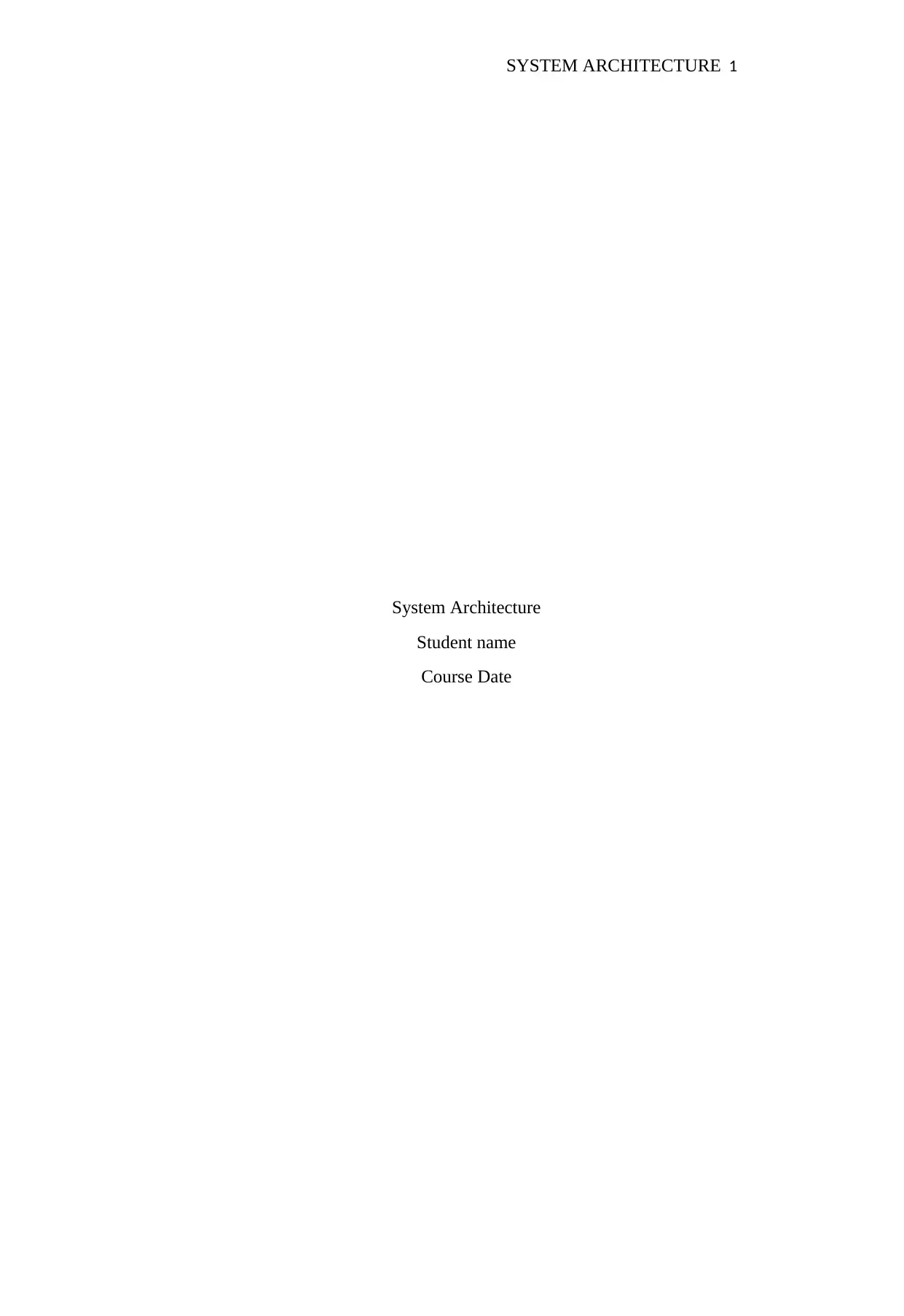
SYSTEM ARCHITECTURE 1
System Architecture
Student name
Course Date
System Architecture
Student name
Course Date
Secure Best Marks with AI Grader
Need help grading? Try our AI Grader for instant feedback on your assignments.
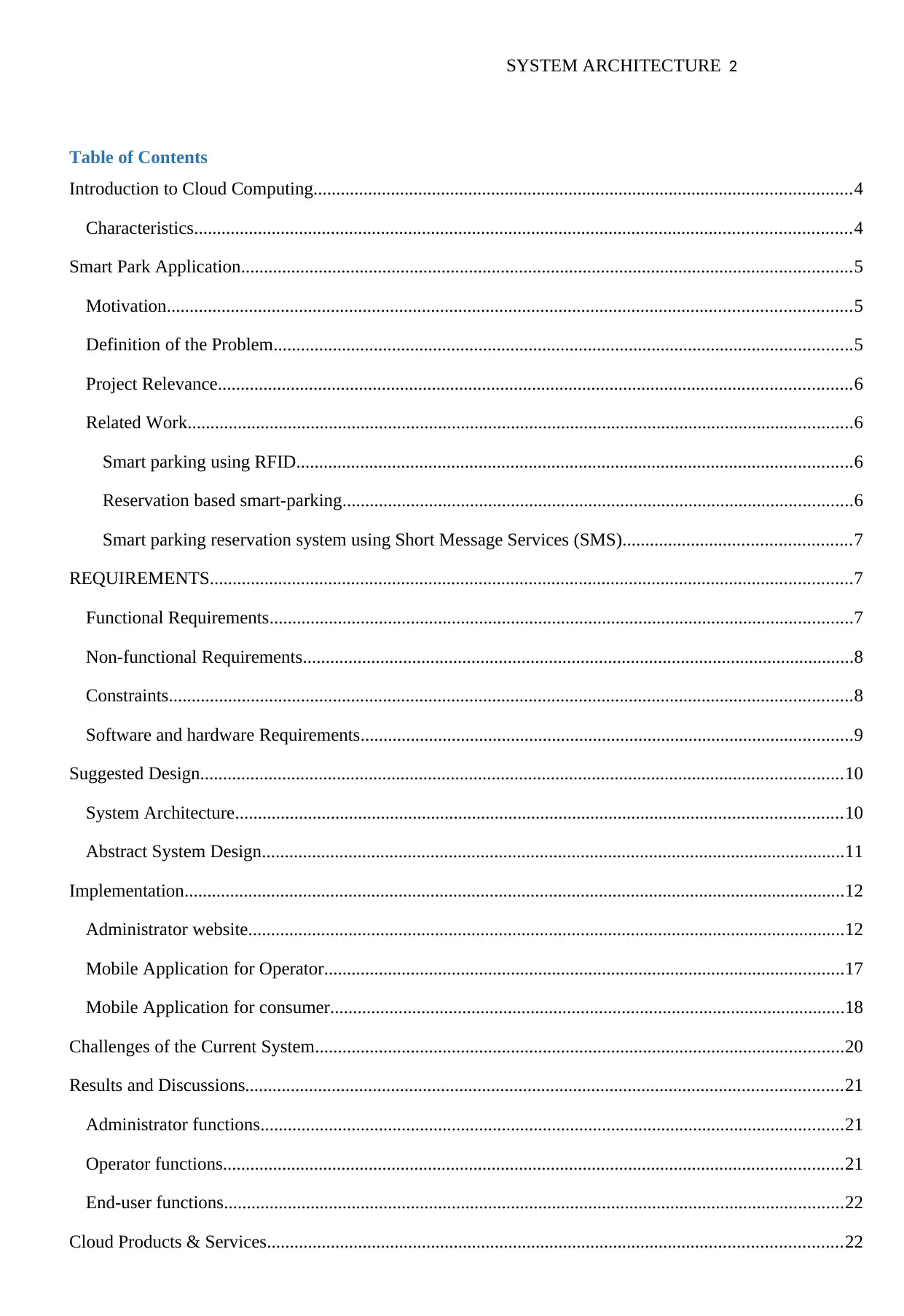
SYSTEM ARCHITECTURE 2
Table of Contents
Introduction to Cloud Computing......................................................................................................................4
Characteristics................................................................................................................................................4
Smart Park Application......................................................................................................................................5
Motivation......................................................................................................................................................5
Definition of the Problem...............................................................................................................................5
Project Relevance...........................................................................................................................................6
Related Work..................................................................................................................................................6
Smart parking using RFID..........................................................................................................................6
Reservation based smart-parking................................................................................................................6
Smart parking reservation system using Short Message Services (SMS)..................................................7
REQUIREMENTS.............................................................................................................................................7
Functional Requirements................................................................................................................................7
Non-functional Requirements.........................................................................................................................8
Constraints......................................................................................................................................................8
Software and hardware Requirements............................................................................................................9
Suggested Design.............................................................................................................................................10
System Architecture.....................................................................................................................................10
Abstract System Design................................................................................................................................11
Implementation.................................................................................................................................................12
Administrator website...................................................................................................................................12
Mobile Application for Operator..................................................................................................................17
Mobile Application for consumer.................................................................................................................18
Challenges of the Current System....................................................................................................................20
Results and Discussions...................................................................................................................................21
Administrator functions................................................................................................................................21
Operator functions........................................................................................................................................21
End-user functions........................................................................................................................................22
Cloud Products & Services..............................................................................................................................22
Table of Contents
Introduction to Cloud Computing......................................................................................................................4
Characteristics................................................................................................................................................4
Smart Park Application......................................................................................................................................5
Motivation......................................................................................................................................................5
Definition of the Problem...............................................................................................................................5
Project Relevance...........................................................................................................................................6
Related Work..................................................................................................................................................6
Smart parking using RFID..........................................................................................................................6
Reservation based smart-parking................................................................................................................6
Smart parking reservation system using Short Message Services (SMS)..................................................7
REQUIREMENTS.............................................................................................................................................7
Functional Requirements................................................................................................................................7
Non-functional Requirements.........................................................................................................................8
Constraints......................................................................................................................................................8
Software and hardware Requirements............................................................................................................9
Suggested Design.............................................................................................................................................10
System Architecture.....................................................................................................................................10
Abstract System Design................................................................................................................................11
Implementation.................................................................................................................................................12
Administrator website...................................................................................................................................12
Mobile Application for Operator..................................................................................................................17
Mobile Application for consumer.................................................................................................................18
Challenges of the Current System....................................................................................................................20
Results and Discussions...................................................................................................................................21
Administrator functions................................................................................................................................21
Operator functions........................................................................................................................................21
End-user functions........................................................................................................................................22
Cloud Products & Services..............................................................................................................................22
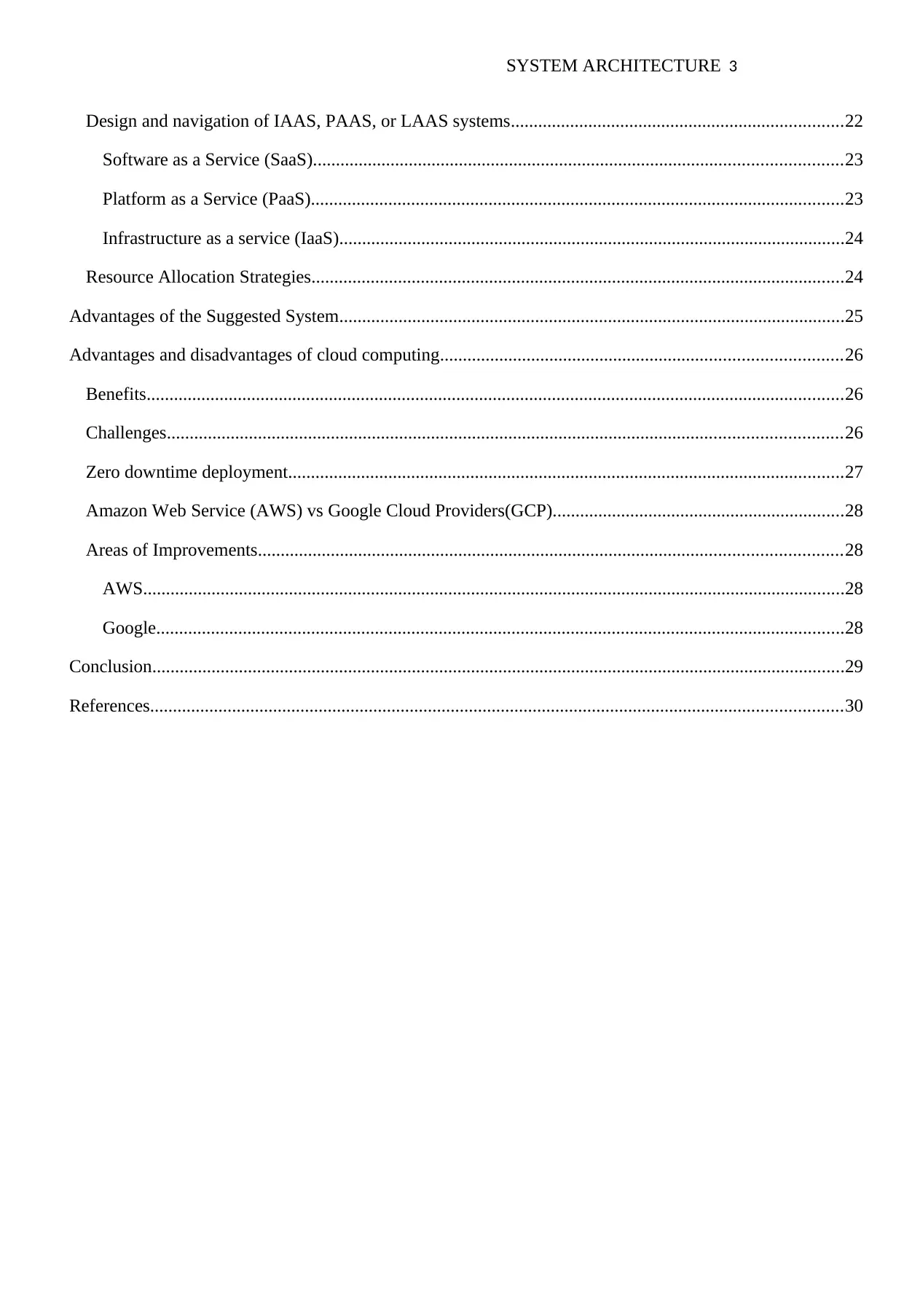
SYSTEM ARCHITECTURE 3
Design and navigation of IAAS, PAAS, or LAAS systems.........................................................................22
Software as a Service (SaaS)....................................................................................................................23
Platform as a Service (PaaS).....................................................................................................................23
Infrastructure as a service (IaaS)...............................................................................................................24
Resource Allocation Strategies.....................................................................................................................24
Advantages of the Suggested System...............................................................................................................25
Advantages and disadvantages of cloud computing........................................................................................26
Benefits.........................................................................................................................................................26
Challenges....................................................................................................................................................26
Zero downtime deployment..........................................................................................................................27
Amazon Web Service (AWS) vs Google Cloud Providers(GCP)................................................................28
Areas of Improvements................................................................................................................................28
AWS..........................................................................................................................................................28
Google.......................................................................................................................................................28
Conclusion........................................................................................................................................................29
References........................................................................................................................................................30
Design and navigation of IAAS, PAAS, or LAAS systems.........................................................................22
Software as a Service (SaaS)....................................................................................................................23
Platform as a Service (PaaS).....................................................................................................................23
Infrastructure as a service (IaaS)...............................................................................................................24
Resource Allocation Strategies.....................................................................................................................24
Advantages of the Suggested System...............................................................................................................25
Advantages and disadvantages of cloud computing........................................................................................26
Benefits.........................................................................................................................................................26
Challenges....................................................................................................................................................26
Zero downtime deployment..........................................................................................................................27
Amazon Web Service (AWS) vs Google Cloud Providers(GCP)................................................................28
Areas of Improvements................................................................................................................................28
AWS..........................................................................................................................................................28
Google.......................................................................................................................................................28
Conclusion........................................................................................................................................................29
References........................................................................................................................................................30
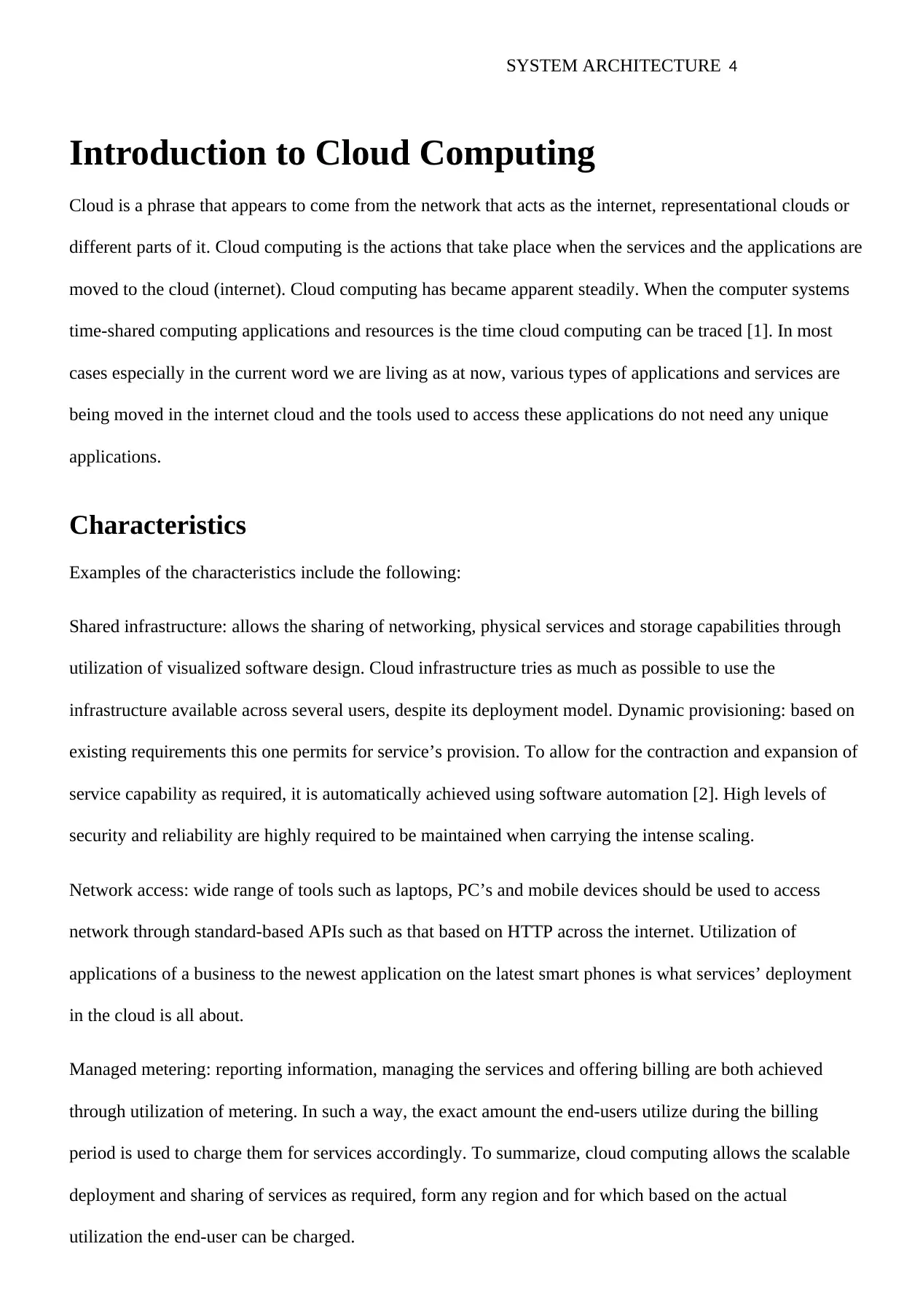
SYSTEM ARCHITECTURE 4
Introduction to Cloud Computing
Cloud is a phrase that appears to come from the network that acts as the internet, representational clouds or
different parts of it. Cloud computing is the actions that take place when the services and the applications are
moved to the cloud (internet). Cloud computing has became apparent steadily. When the computer systems
time-shared computing applications and resources is the time cloud computing can be traced [1]. In most
cases especially in the current word we are living as at now, various types of applications and services are
being moved in the internet cloud and the tools used to access these applications do not need any unique
applications.
Characteristics
Examples of the characteristics include the following:
Shared infrastructure: allows the sharing of networking, physical services and storage capabilities through
utilization of visualized software design. Cloud infrastructure tries as much as possible to use the
infrastructure available across several users, despite its deployment model. Dynamic provisioning: based on
existing requirements this one permits for service’s provision. To allow for the contraction and expansion of
service capability as required, it is automatically achieved using software automation [2]. High levels of
security and reliability are highly required to be maintained when carrying the intense scaling.
Network access: wide range of tools such as laptops, PC’s and mobile devices should be used to access
network through standard-based APIs such as that based on HTTP across the internet. Utilization of
applications of a business to the newest application on the latest smart phones is what services’ deployment
in the cloud is all about.
Managed metering: reporting information, managing the services and offering billing are both achieved
through utilization of metering. In such a way, the exact amount the end-users utilize during the billing
period is used to charge them for services accordingly. To summarize, cloud computing allows the scalable
deployment and sharing of services as required, form any region and for which based on the actual
utilization the end-user can be charged.
Introduction to Cloud Computing
Cloud is a phrase that appears to come from the network that acts as the internet, representational clouds or
different parts of it. Cloud computing is the actions that take place when the services and the applications are
moved to the cloud (internet). Cloud computing has became apparent steadily. When the computer systems
time-shared computing applications and resources is the time cloud computing can be traced [1]. In most
cases especially in the current word we are living as at now, various types of applications and services are
being moved in the internet cloud and the tools used to access these applications do not need any unique
applications.
Characteristics
Examples of the characteristics include the following:
Shared infrastructure: allows the sharing of networking, physical services and storage capabilities through
utilization of visualized software design. Cloud infrastructure tries as much as possible to use the
infrastructure available across several users, despite its deployment model. Dynamic provisioning: based on
existing requirements this one permits for service’s provision. To allow for the contraction and expansion of
service capability as required, it is automatically achieved using software automation [2]. High levels of
security and reliability are highly required to be maintained when carrying the intense scaling.
Network access: wide range of tools such as laptops, PC’s and mobile devices should be used to access
network through standard-based APIs such as that based on HTTP across the internet. Utilization of
applications of a business to the newest application on the latest smart phones is what services’ deployment
in the cloud is all about.
Managed metering: reporting information, managing the services and offering billing are both achieved
through utilization of metering. In such a way, the exact amount the end-users utilize during the billing
period is used to charge them for services accordingly. To summarize, cloud computing allows the scalable
deployment and sharing of services as required, form any region and for which based on the actual
utilization the end-user can be charged.
Secure Best Marks with AI Grader
Need help grading? Try our AI Grader for instant feedback on your assignments.
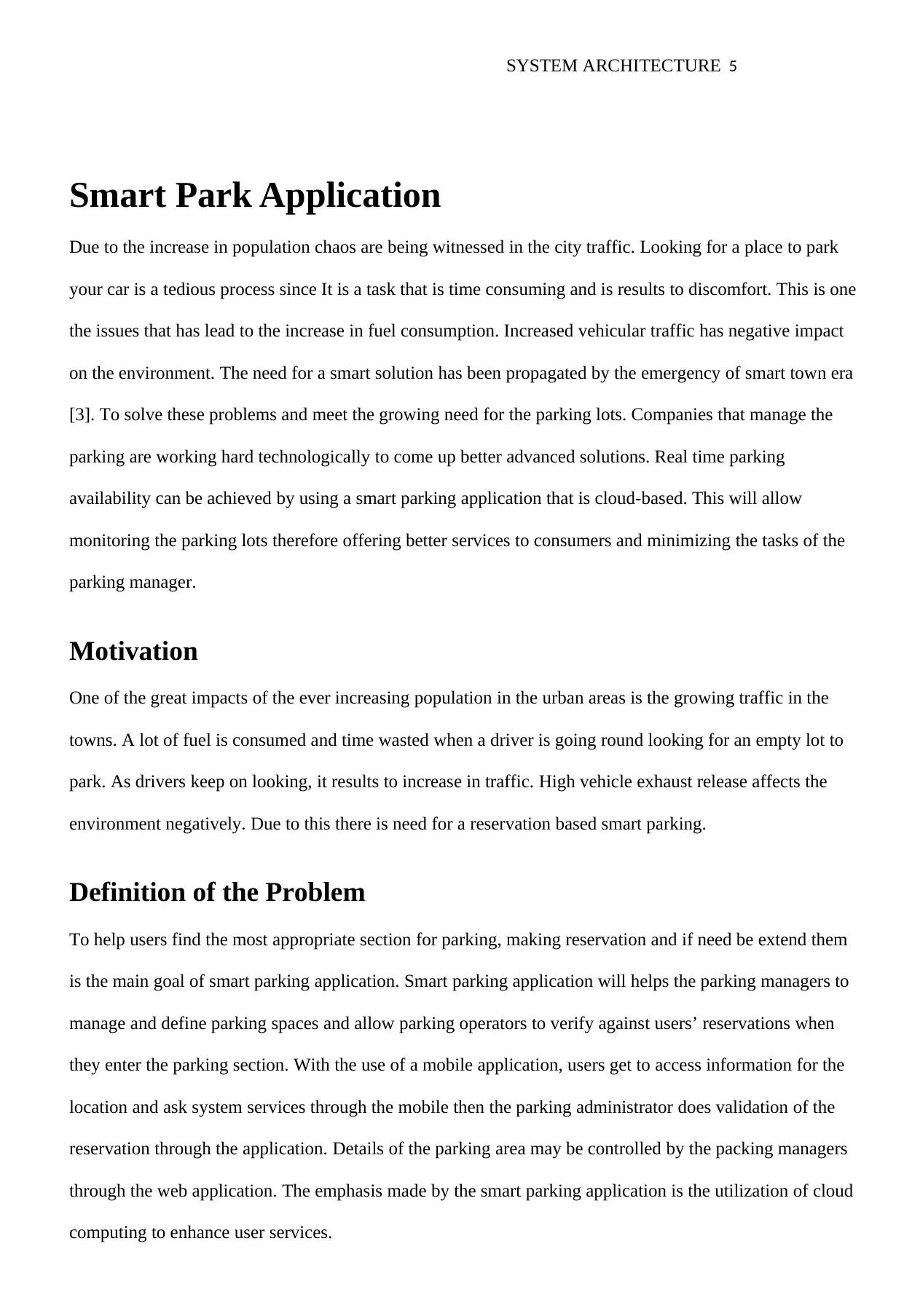
SYSTEM ARCHITECTURE 5
Smart Park Application
Due to the increase in population chaos are being witnessed in the city traffic. Looking for a place to park
your car is a tedious process since It is a task that is time consuming and is results to discomfort. This is one
the issues that has lead to the increase in fuel consumption. Increased vehicular traffic has negative impact
on the environment. The need for a smart solution has been propagated by the emergency of smart town era
[3]. To solve these problems and meet the growing need for the parking lots. Companies that manage the
parking are working hard technologically to come up better advanced solutions. Real time parking
availability can be achieved by using a smart parking application that is cloud-based. This will allow
monitoring the parking lots therefore offering better services to consumers and minimizing the tasks of the
parking manager.
Motivation
One of the great impacts of the ever increasing population in the urban areas is the growing traffic in the
towns. A lot of fuel is consumed and time wasted when a driver is going round looking for an empty lot to
park. As drivers keep on looking, it results to increase in traffic. High vehicle exhaust release affects the
environment negatively. Due to this there is need for a reservation based smart parking.
Definition of the Problem
To help users find the most appropriate section for parking, making reservation and if need be extend them
is the main goal of smart parking application. Smart parking application will helps the parking managers to
manage and define parking spaces and allow parking operators to verify against users’ reservations when
they enter the parking section. With the use of a mobile application, users get to access information for the
location and ask system services through the mobile then the parking administrator does validation of the
reservation through the application. Details of the parking area may be controlled by the packing managers
through the web application. The emphasis made by the smart parking application is the utilization of cloud
computing to enhance user services.
Smart Park Application
Due to the increase in population chaos are being witnessed in the city traffic. Looking for a place to park
your car is a tedious process since It is a task that is time consuming and is results to discomfort. This is one
the issues that has lead to the increase in fuel consumption. Increased vehicular traffic has negative impact
on the environment. The need for a smart solution has been propagated by the emergency of smart town era
[3]. To solve these problems and meet the growing need for the parking lots. Companies that manage the
parking are working hard technologically to come up better advanced solutions. Real time parking
availability can be achieved by using a smart parking application that is cloud-based. This will allow
monitoring the parking lots therefore offering better services to consumers and minimizing the tasks of the
parking manager.
Motivation
One of the great impacts of the ever increasing population in the urban areas is the growing traffic in the
towns. A lot of fuel is consumed and time wasted when a driver is going round looking for an empty lot to
park. As drivers keep on looking, it results to increase in traffic. High vehicle exhaust release affects the
environment negatively. Due to this there is need for a reservation based smart parking.
Definition of the Problem
To help users find the most appropriate section for parking, making reservation and if need be extend them
is the main goal of smart parking application. Smart parking application will helps the parking managers to
manage and define parking spaces and allow parking operators to verify against users’ reservations when
they enter the parking section. With the use of a mobile application, users get to access information for the
location and ask system services through the mobile then the parking administrator does validation of the
reservation through the application. Details of the parking area may be controlled by the packing managers
through the web application. The emphasis made by the smart parking application is the utilization of cloud
computing to enhance user services.
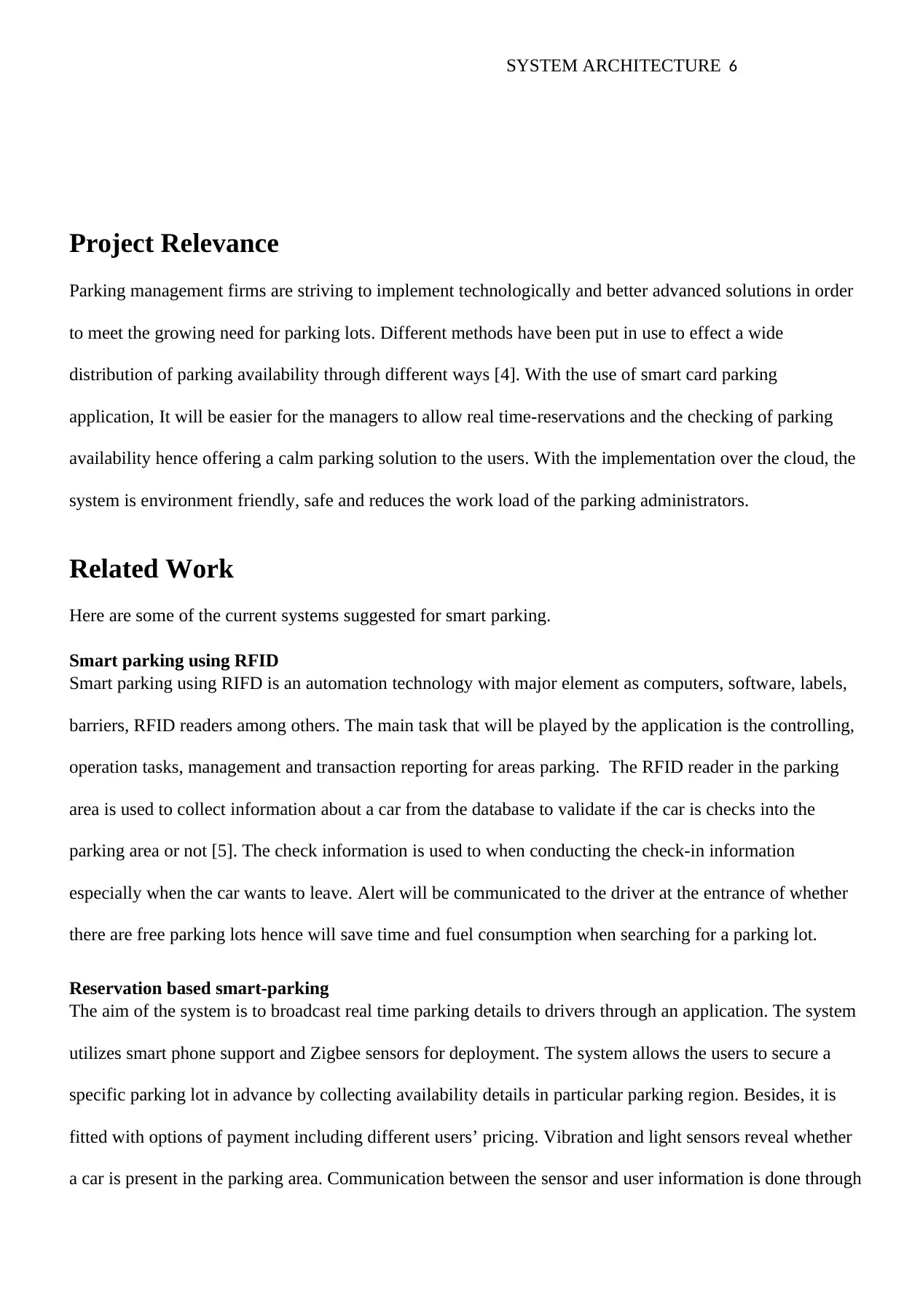
SYSTEM ARCHITECTURE 6
Project Relevance
Parking management firms are striving to implement technologically and better advanced solutions in order
to meet the growing need for parking lots. Different methods have been put in use to effect a wide
distribution of parking availability through different ways [4]. With the use of smart card parking
application, It will be easier for the managers to allow real time-reservations and the checking of parking
availability hence offering a calm parking solution to the users. With the implementation over the cloud, the
system is environment friendly, safe and reduces the work load of the parking administrators.
Related Work
Here are some of the current systems suggested for smart parking.
Smart parking using RFID
Smart parking using RIFD is an automation technology with major element as computers, software, labels,
barriers, RFID readers among others. The main task that will be played by the application is the controlling,
operation tasks, management and transaction reporting for areas parking. The RFID reader in the parking
area is used to collect information about a car from the database to validate if the car is checks into the
parking area or not [5]. The check information is used to when conducting the check-in information
especially when the car wants to leave. Alert will be communicated to the driver at the entrance of whether
there are free parking lots hence will save time and fuel consumption when searching for a parking lot.
Reservation based smart-parking
The aim of the system is to broadcast real time parking details to drivers through an application. The system
utilizes smart phone support and Zigbee sensors for deployment. The system allows the users to secure a
specific parking lot in advance by collecting availability details in particular parking region. Besides, it is
fitted with options of payment including different users’ pricing. Vibration and light sensors reveal whether
a car is present in the parking area. Communication between the sensor and user information is done through
Project Relevance
Parking management firms are striving to implement technologically and better advanced solutions in order
to meet the growing need for parking lots. Different methods have been put in use to effect a wide
distribution of parking availability through different ways [4]. With the use of smart card parking
application, It will be easier for the managers to allow real time-reservations and the checking of parking
availability hence offering a calm parking solution to the users. With the implementation over the cloud, the
system is environment friendly, safe and reduces the work load of the parking administrators.
Related Work
Here are some of the current systems suggested for smart parking.
Smart parking using RFID
Smart parking using RIFD is an automation technology with major element as computers, software, labels,
barriers, RFID readers among others. The main task that will be played by the application is the controlling,
operation tasks, management and transaction reporting for areas parking. The RFID reader in the parking
area is used to collect information about a car from the database to validate if the car is checks into the
parking area or not [5]. The check information is used to when conducting the check-in information
especially when the car wants to leave. Alert will be communicated to the driver at the entrance of whether
there are free parking lots hence will save time and fuel consumption when searching for a parking lot.
Reservation based smart-parking
The aim of the system is to broadcast real time parking details to drivers through an application. The system
utilizes smart phone support and Zigbee sensors for deployment. The system allows the users to secure a
specific parking lot in advance by collecting availability details in particular parking region. Besides, it is
fitted with options of payment including different users’ pricing. Vibration and light sensors reveal whether
a car is present in the parking area. Communication between the sensor and user information is done through
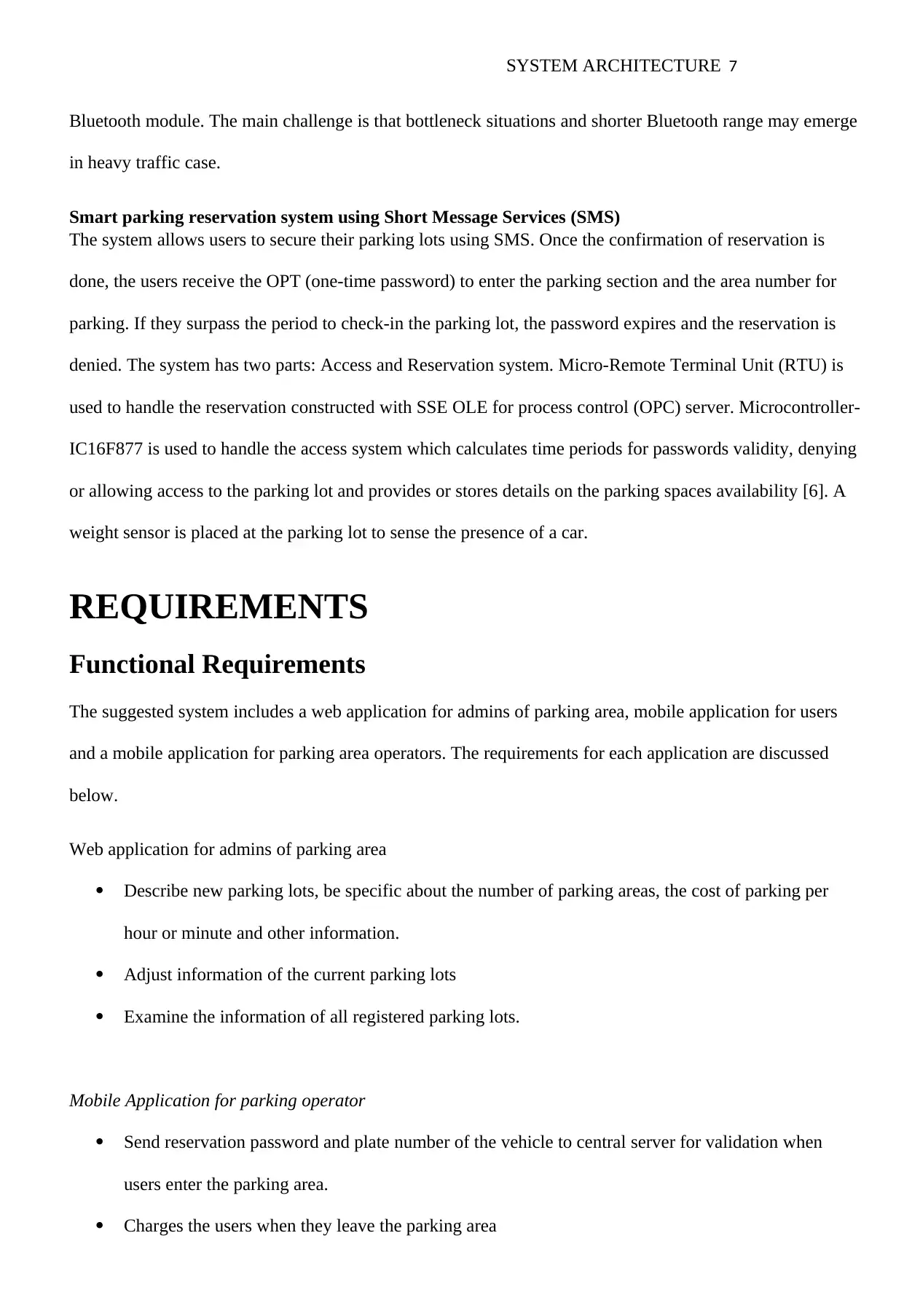
SYSTEM ARCHITECTURE 7
Bluetooth module. The main challenge is that bottleneck situations and shorter Bluetooth range may emerge
in heavy traffic case.
Smart parking reservation system using Short Message Services (SMS)
The system allows users to secure their parking lots using SMS. Once the confirmation of reservation is
done, the users receive the OPT (one-time password) to enter the parking section and the area number for
parking. If they surpass the period to check-in the parking lot, the password expires and the reservation is
denied. The system has two parts: Access and Reservation system. Micro-Remote Terminal Unit (RTU) is
used to handle the reservation constructed with SSE OLE for process control (OPC) server. Microcontroller-
IC16F877 is used to handle the access system which calculates time periods for passwords validity, denying
or allowing access to the parking lot and provides or stores details on the parking spaces availability [6]. A
weight sensor is placed at the parking lot to sense the presence of a car.
REQUIREMENTS
Functional Requirements
The suggested system includes a web application for admins of parking area, mobile application for users
and a mobile application for parking area operators. The requirements for each application are discussed
below.
Web application for admins of parking area
Describe new parking lots, be specific about the number of parking areas, the cost of parking per
hour or minute and other information.
Adjust information of the current parking lots
Examine the information of all registered parking lots.
Mobile Application for parking operator
Send reservation password and plate number of the vehicle to central server for validation when
users enter the parking area.
Charges the users when they leave the parking area
Bluetooth module. The main challenge is that bottleneck situations and shorter Bluetooth range may emerge
in heavy traffic case.
Smart parking reservation system using Short Message Services (SMS)
The system allows users to secure their parking lots using SMS. Once the confirmation of reservation is
done, the users receive the OPT (one-time password) to enter the parking section and the area number for
parking. If they surpass the period to check-in the parking lot, the password expires and the reservation is
denied. The system has two parts: Access and Reservation system. Micro-Remote Terminal Unit (RTU) is
used to handle the reservation constructed with SSE OLE for process control (OPC) server. Microcontroller-
IC16F877 is used to handle the access system which calculates time periods for passwords validity, denying
or allowing access to the parking lot and provides or stores details on the parking spaces availability [6]. A
weight sensor is placed at the parking lot to sense the presence of a car.
REQUIREMENTS
Functional Requirements
The suggested system includes a web application for admins of parking area, mobile application for users
and a mobile application for parking area operators. The requirements for each application are discussed
below.
Web application for admins of parking area
Describe new parking lots, be specific about the number of parking areas, the cost of parking per
hour or minute and other information.
Adjust information of the current parking lots
Examine the information of all registered parking lots.
Mobile Application for parking operator
Send reservation password and plate number of the vehicle to central server for validation when
users enter the parking area.
Charges the users when they leave the parking area
Paraphrase This Document
Need a fresh take? Get an instant paraphrase of this document with our AI Paraphraser
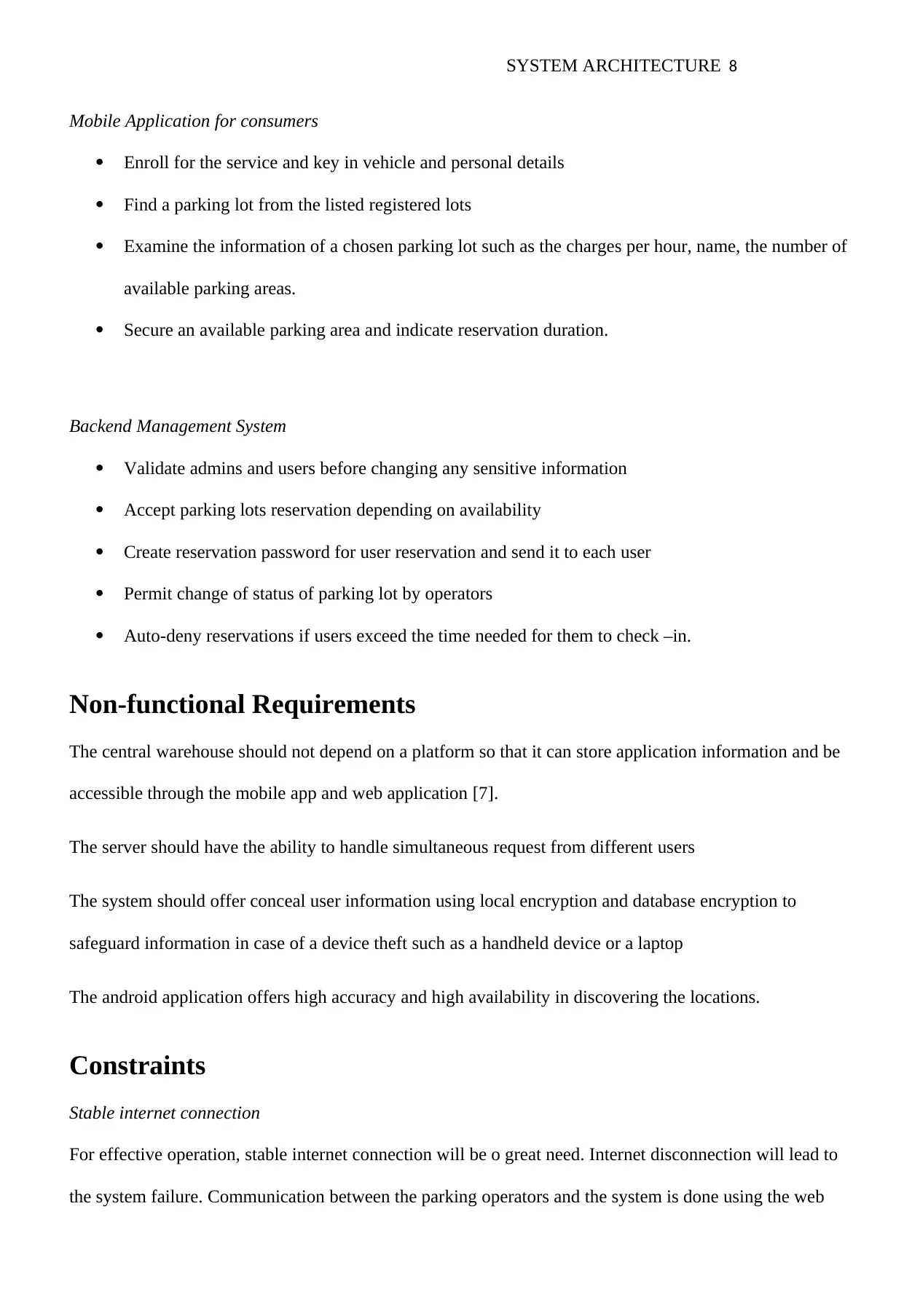
SYSTEM ARCHITECTURE 8
Mobile Application for consumers
Enroll for the service and key in vehicle and personal details
Find a parking lot from the listed registered lots
Examine the information of a chosen parking lot such as the charges per hour, name, the number of
available parking areas.
Secure an available parking area and indicate reservation duration.
Backend Management System
Validate admins and users before changing any sensitive information
Accept parking lots reservation depending on availability
Create reservation password for user reservation and send it to each user
Permit change of status of parking lot by operators
Auto-deny reservations if users exceed the time needed for them to check –in.
Non-functional Requirements
The central warehouse should not depend on a platform so that it can store application information and be
accessible through the mobile app and web application [7].
The server should have the ability to handle simultaneous request from different users
The system should offer conceal user information using local encryption and database encryption to
safeguard information in case of a device theft such as a handheld device or a laptop
The android application offers high accuracy and high availability in discovering the locations.
Constraints
Stable internet connection
For effective operation, stable internet connection will be o great need. Internet disconnection will lead to
the system failure. Communication between the parking operators and the system is done using the web
Mobile Application for consumers
Enroll for the service and key in vehicle and personal details
Find a parking lot from the listed registered lots
Examine the information of a chosen parking lot such as the charges per hour, name, the number of
available parking areas.
Secure an available parking area and indicate reservation duration.
Backend Management System
Validate admins and users before changing any sensitive information
Accept parking lots reservation depending on availability
Create reservation password for user reservation and send it to each user
Permit change of status of parking lot by operators
Auto-deny reservations if users exceed the time needed for them to check –in.
Non-functional Requirements
The central warehouse should not depend on a platform so that it can store application information and be
accessible through the mobile app and web application [7].
The server should have the ability to handle simultaneous request from different users
The system should offer conceal user information using local encryption and database encryption to
safeguard information in case of a device theft such as a handheld device or a laptop
The android application offers high accuracy and high availability in discovering the locations.
Constraints
Stable internet connection
For effective operation, stable internet connection will be o great need. Internet disconnection will lead to
the system failure. Communication between the parking operators and the system is done using the web
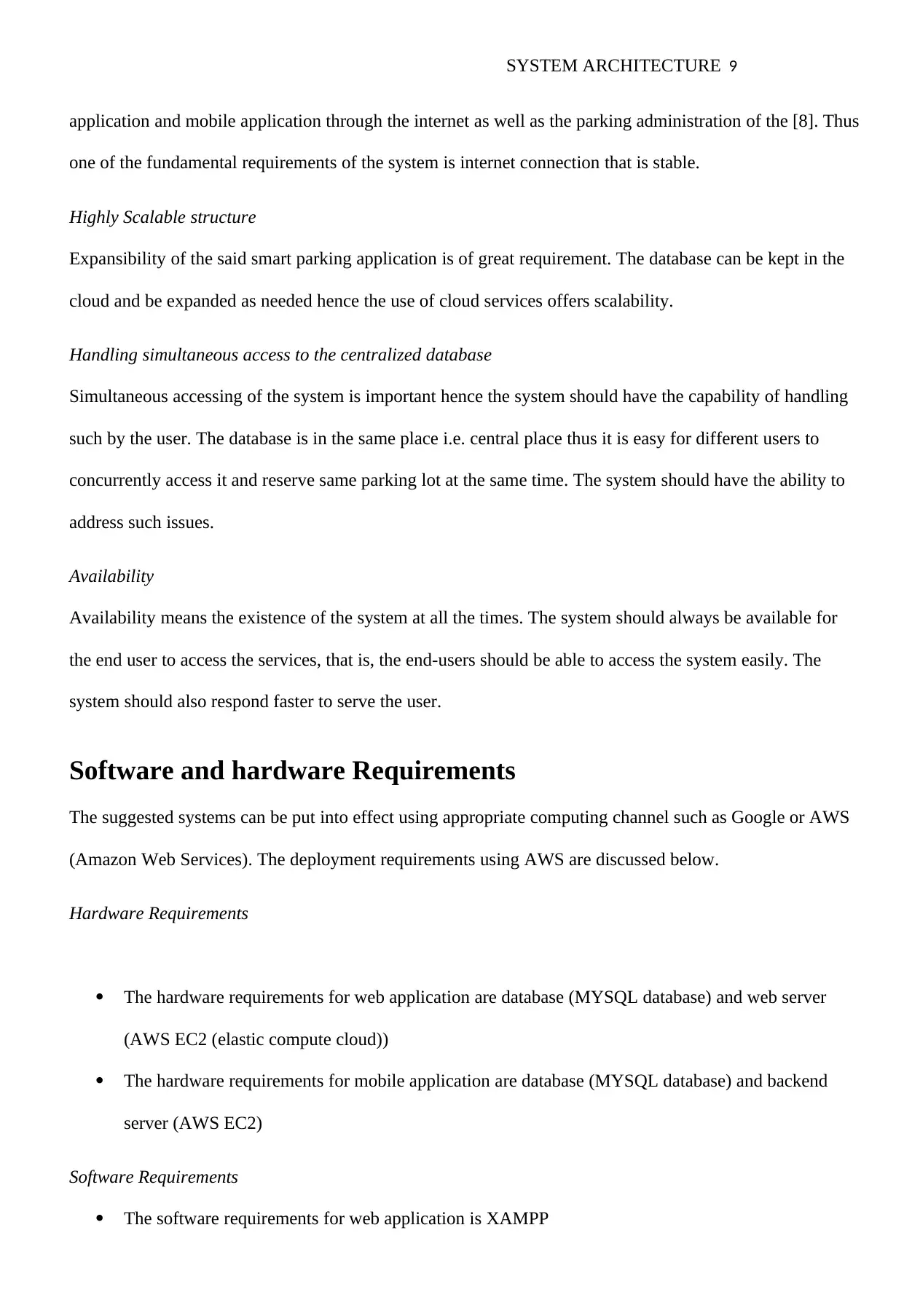
SYSTEM ARCHITECTURE 9
application and mobile application through the internet as well as the parking administration of the [8]. Thus
one of the fundamental requirements of the system is internet connection that is stable.
Highly Scalable structure
Expansibility of the said smart parking application is of great requirement. The database can be kept in the
cloud and be expanded as needed hence the use of cloud services offers scalability.
Handling simultaneous access to the centralized database
Simultaneous accessing of the system is important hence the system should have the capability of handling
such by the user. The database is in the same place i.e. central place thus it is easy for different users to
concurrently access it and reserve same parking lot at the same time. The system should have the ability to
address such issues.
Availability
Availability means the existence of the system at all the times. The system should always be available for
the end user to access the services, that is, the end-users should be able to access the system easily. The
system should also respond faster to serve the user.
Software and hardware Requirements
The suggested systems can be put into effect using appropriate computing channel such as Google or AWS
(Amazon Web Services). The deployment requirements using AWS are discussed below.
Hardware Requirements
The hardware requirements for web application are database (MYSQL database) and web server
(AWS EC2 (elastic compute cloud))
The hardware requirements for mobile application are database (MYSQL database) and backend
server (AWS EC2)
Software Requirements
The software requirements for web application is XAMPP
application and mobile application through the internet as well as the parking administration of the [8]. Thus
one of the fundamental requirements of the system is internet connection that is stable.
Highly Scalable structure
Expansibility of the said smart parking application is of great requirement. The database can be kept in the
cloud and be expanded as needed hence the use of cloud services offers scalability.
Handling simultaneous access to the centralized database
Simultaneous accessing of the system is important hence the system should have the capability of handling
such by the user. The database is in the same place i.e. central place thus it is easy for different users to
concurrently access it and reserve same parking lot at the same time. The system should have the ability to
address such issues.
Availability
Availability means the existence of the system at all the times. The system should always be available for
the end user to access the services, that is, the end-users should be able to access the system easily. The
system should also respond faster to serve the user.
Software and hardware Requirements
The suggested systems can be put into effect using appropriate computing channel such as Google or AWS
(Amazon Web Services). The deployment requirements using AWS are discussed below.
Hardware Requirements
The hardware requirements for web application are database (MYSQL database) and web server
(AWS EC2 (elastic compute cloud))
The hardware requirements for mobile application are database (MYSQL database) and backend
server (AWS EC2)
Software Requirements
The software requirements for web application is XAMPP
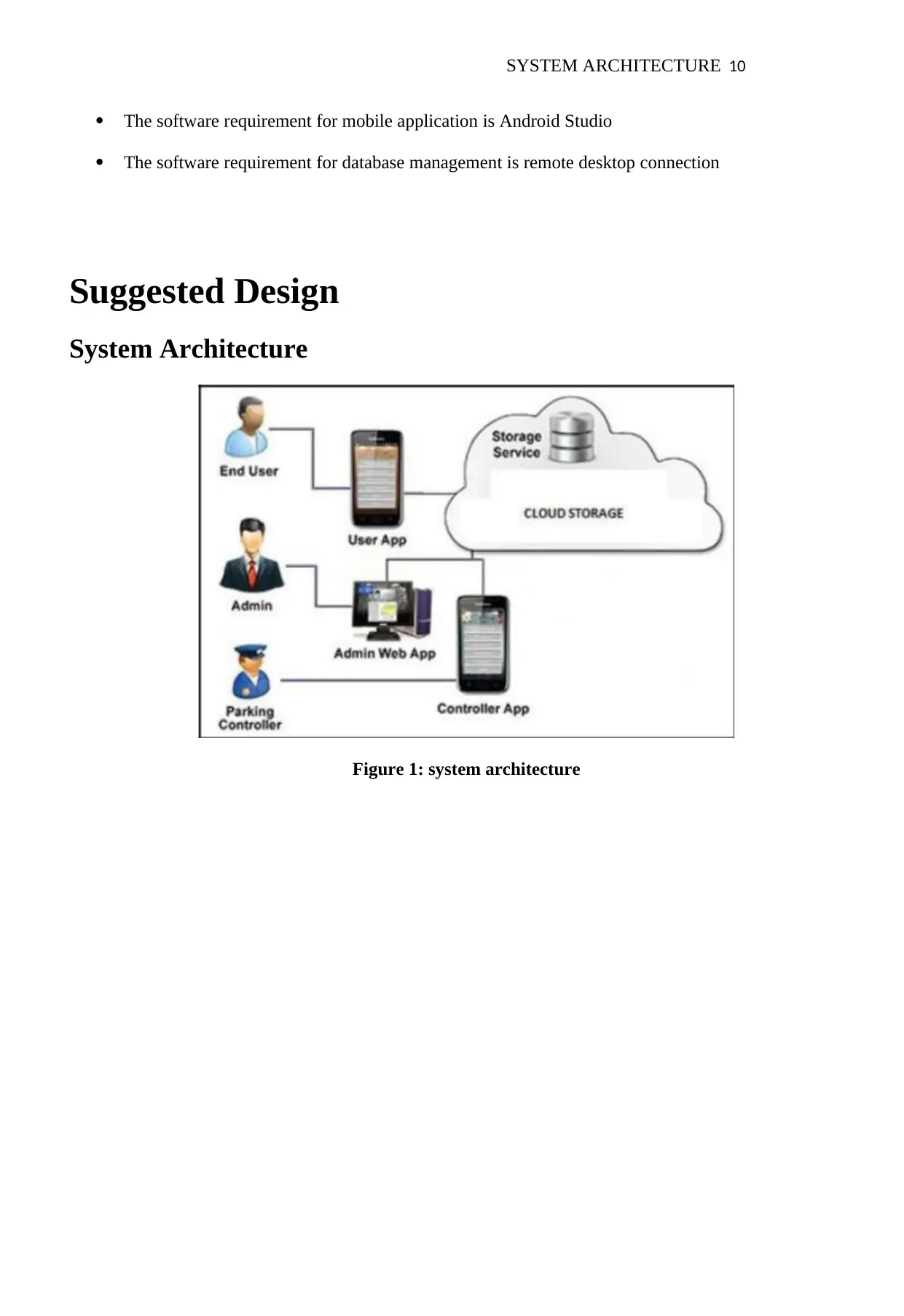
SYSTEM ARCHITECTURE 10
The software requirement for mobile application is Android Studio
The software requirement for database management is remote desktop connection
Suggested Design
System Architecture
Figure 1: system architecture
The software requirement for mobile application is Android Studio
The software requirement for database management is remote desktop connection
Suggested Design
System Architecture
Figure 1: system architecture
Secure Best Marks with AI Grader
Need help grading? Try our AI Grader for instant feedback on your assignments.
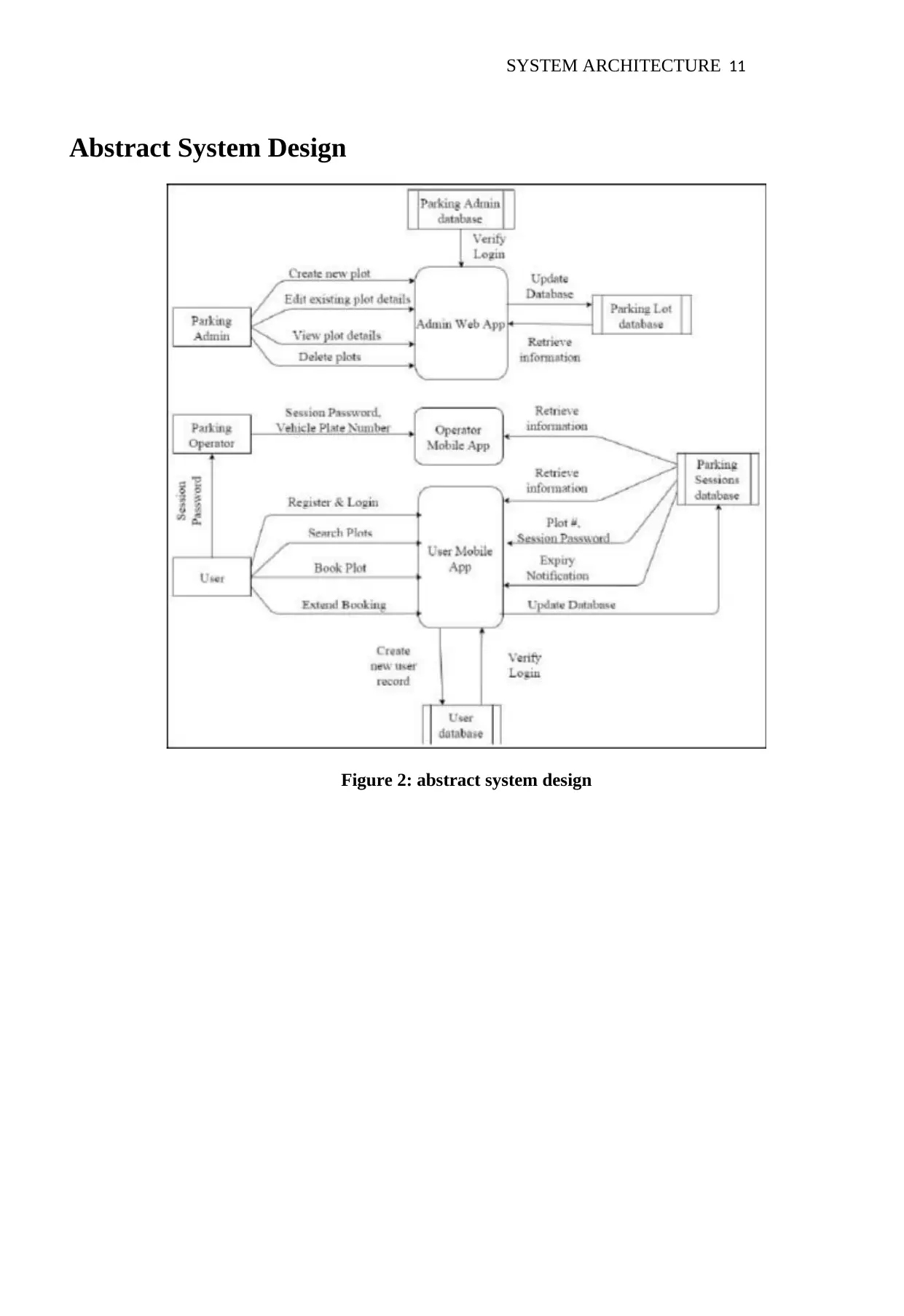
SYSTEM ARCHITECTURE 11
Abstract System Design
Figure 2: abstract system design
Abstract System Design
Figure 2: abstract system design
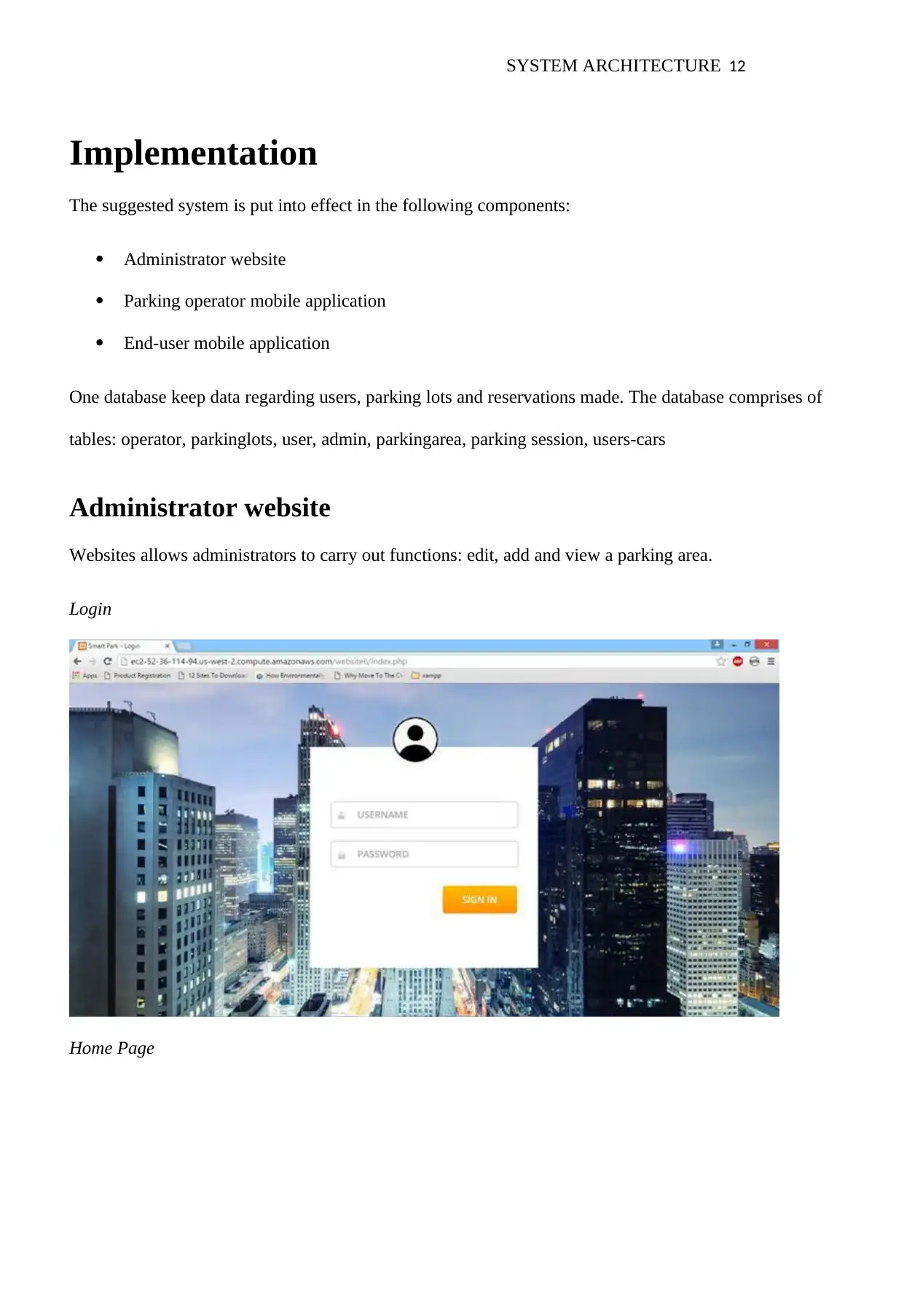
SYSTEM ARCHITECTURE 12
Implementation
The suggested system is put into effect in the following components:
Administrator website
Parking operator mobile application
End-user mobile application
One database keep data regarding users, parking lots and reservations made. The database comprises of
tables: operator, parkinglots, user, admin, parkingarea, parking session, users-cars
Administrator website
Websites allows administrators to carry out functions: edit, add and view a parking area.
Login
Home Page
Implementation
The suggested system is put into effect in the following components:
Administrator website
Parking operator mobile application
End-user mobile application
One database keep data regarding users, parking lots and reservations made. The database comprises of
tables: operator, parkinglots, user, admin, parkingarea, parking session, users-cars
Administrator website
Websites allows administrators to carry out functions: edit, add and view a parking area.
Login
Home Page
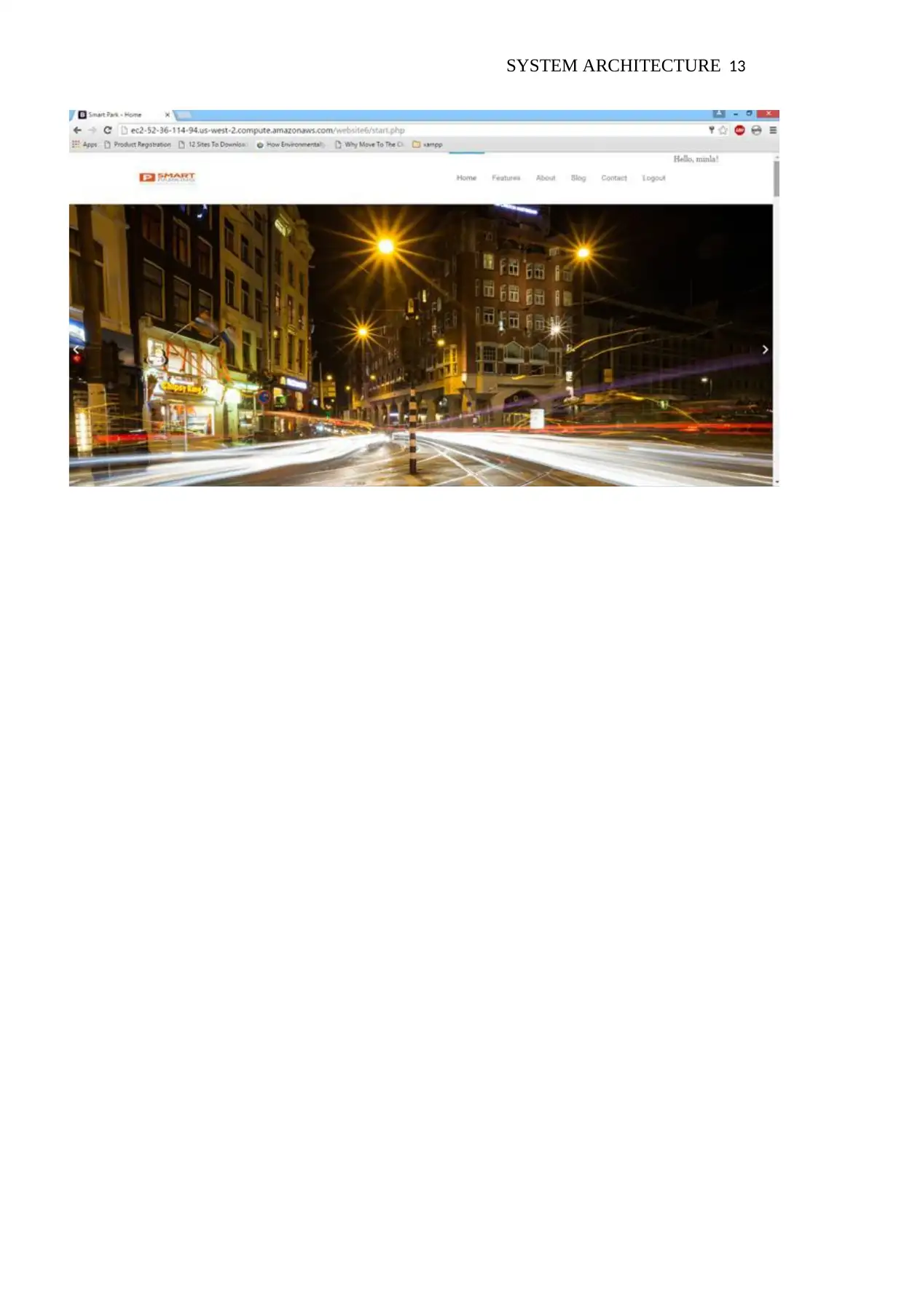
SYSTEM ARCHITECTURE 13
Paraphrase This Document
Need a fresh take? Get an instant paraphrase of this document with our AI Paraphraser
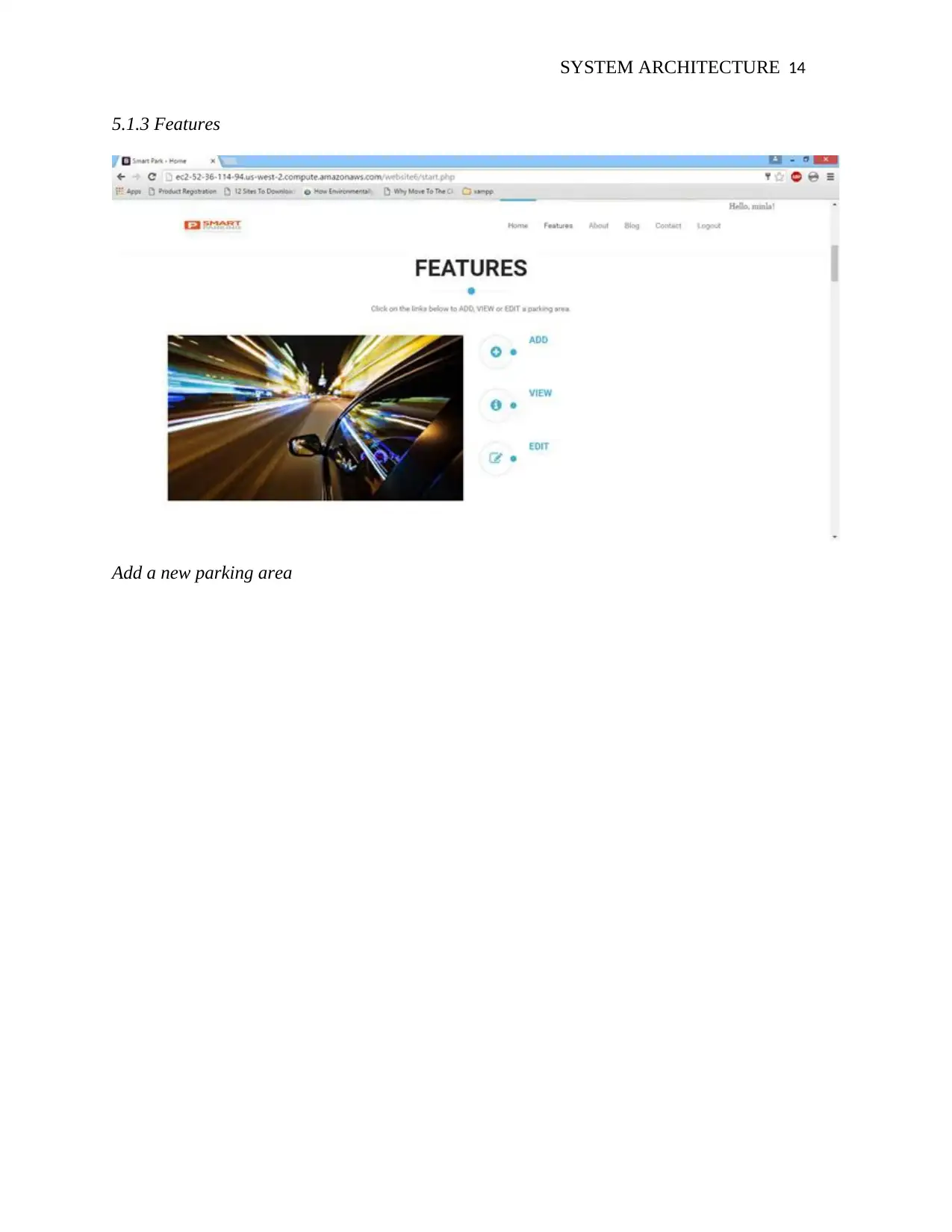
SYSTEM ARCHITECTURE 14
5.1.3 Features
Add a new parking area
5.1.3 Features
Add a new parking area
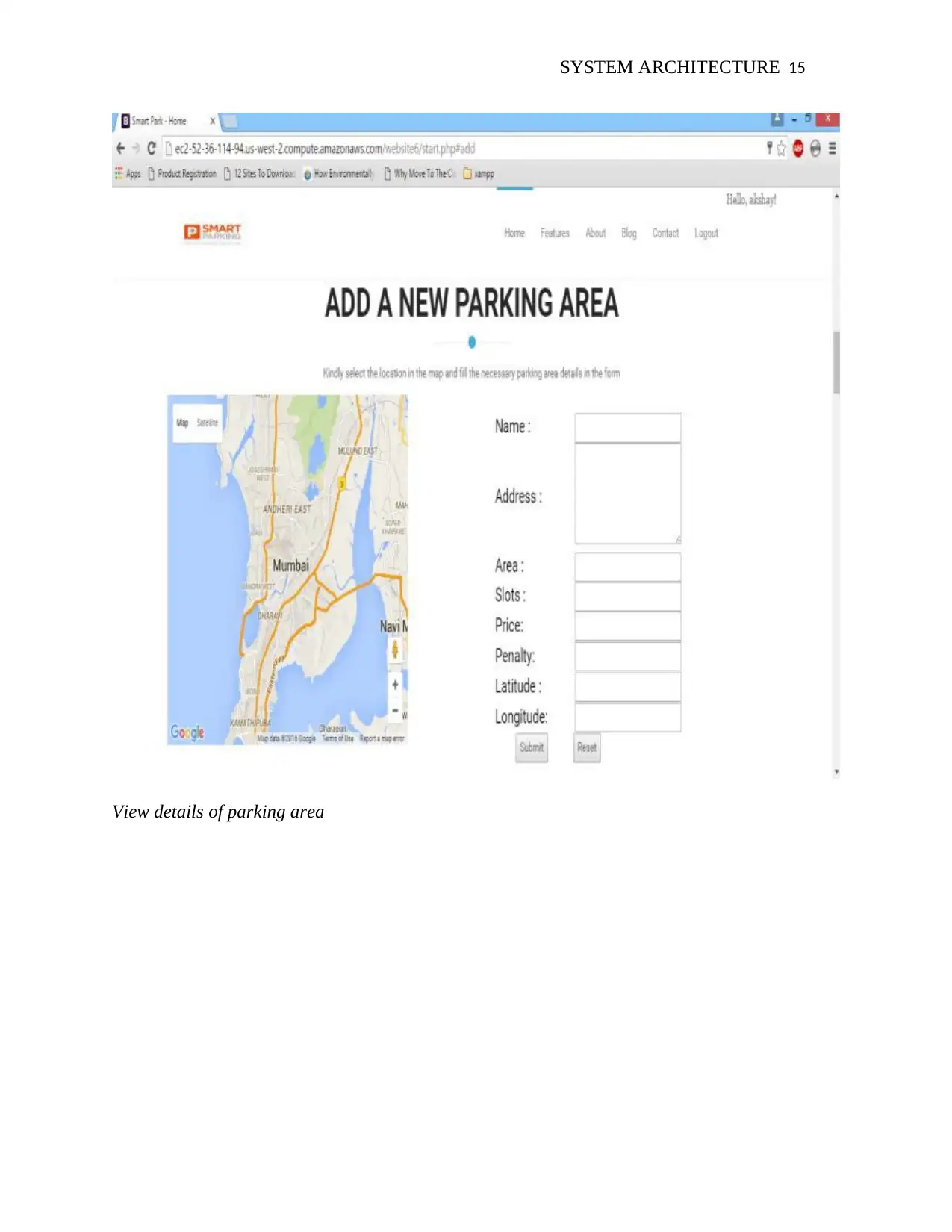
SYSTEM ARCHITECTURE 15
View details of parking area
View details of parking area
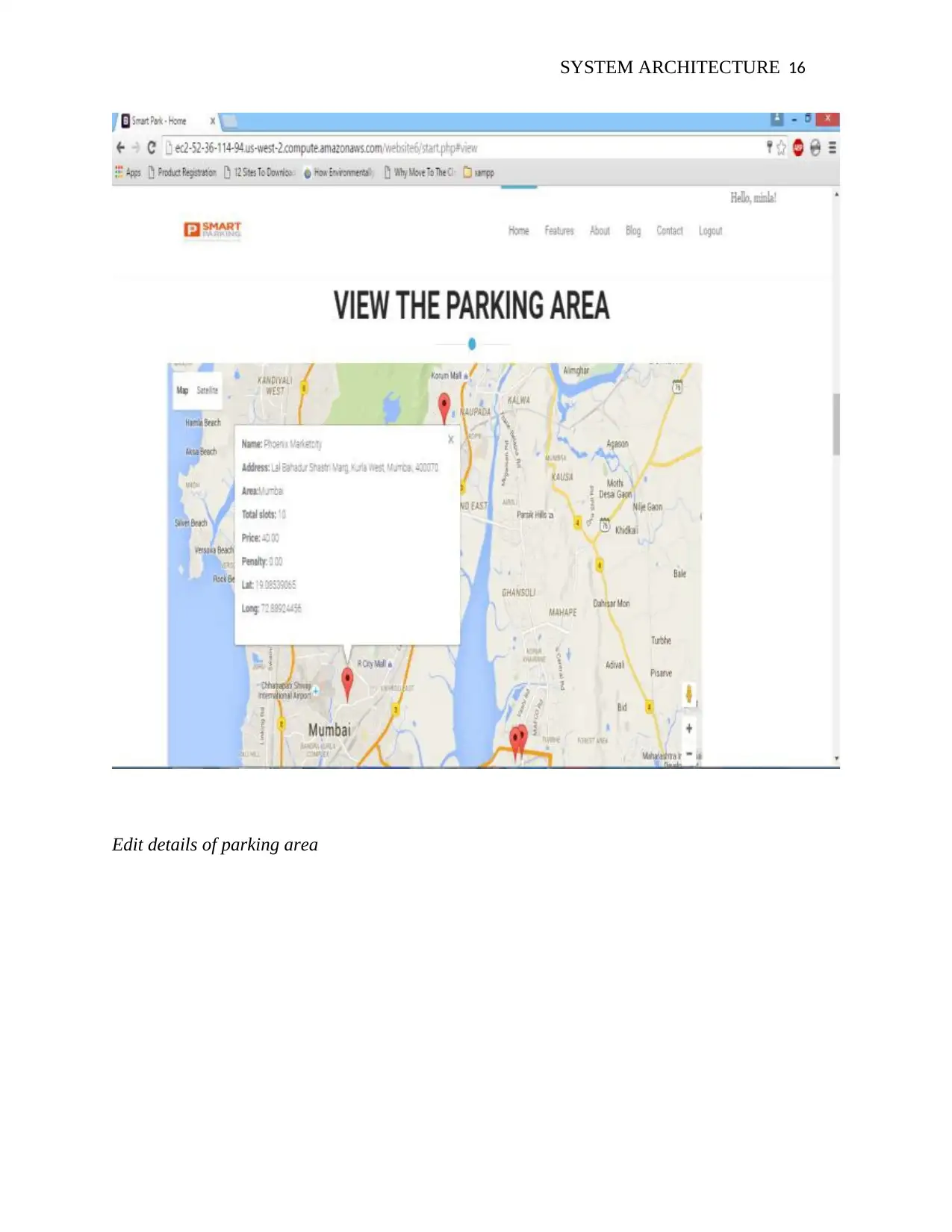
SYSTEM ARCHITECTURE 16
Edit details of parking area
Edit details of parking area
Secure Best Marks with AI Grader
Need help grading? Try our AI Grader for instant feedback on your assignments.
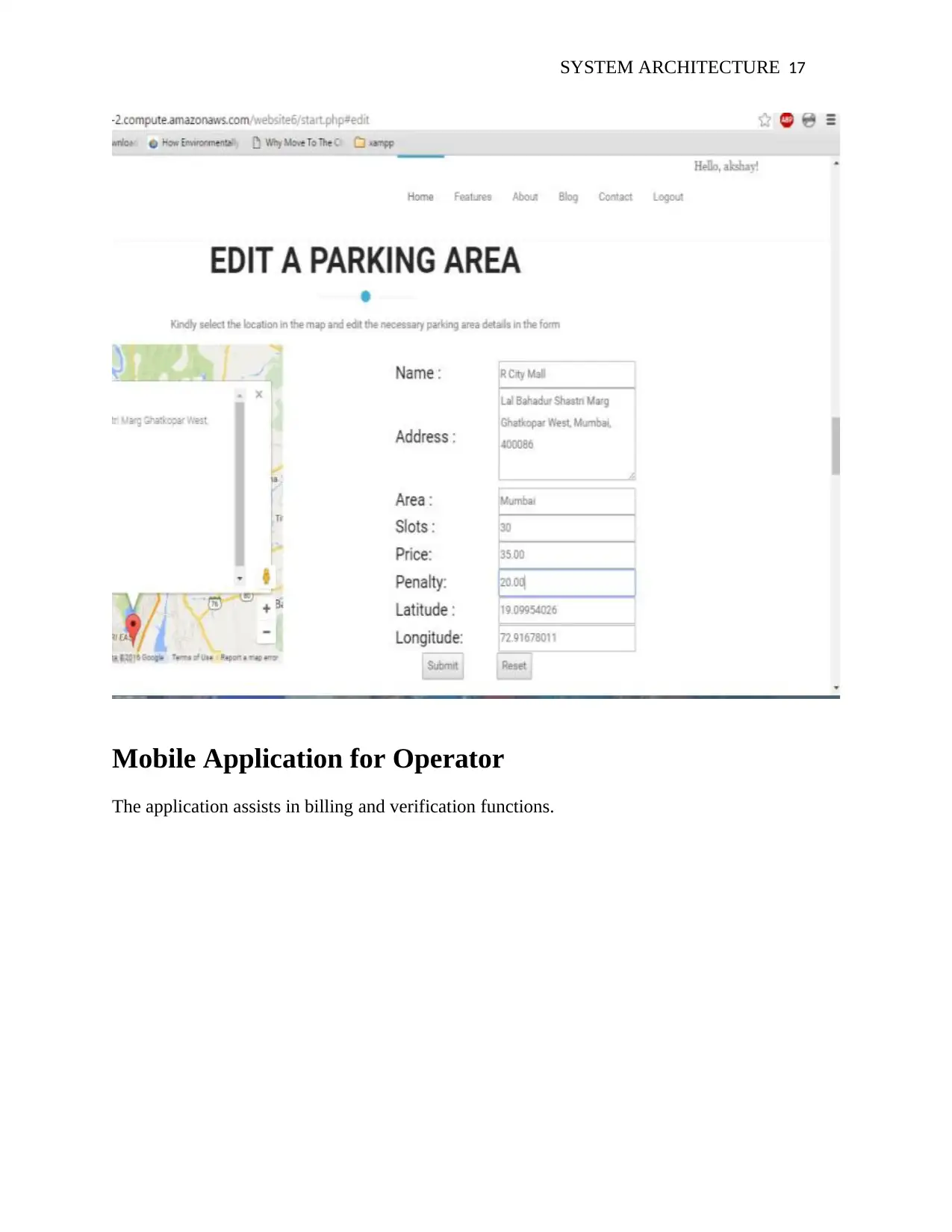
SYSTEM ARCHITECTURE 17
Mobile Application for Operator
The application assists in billing and verification functions.
Mobile Application for Operator
The application assists in billing and verification functions.
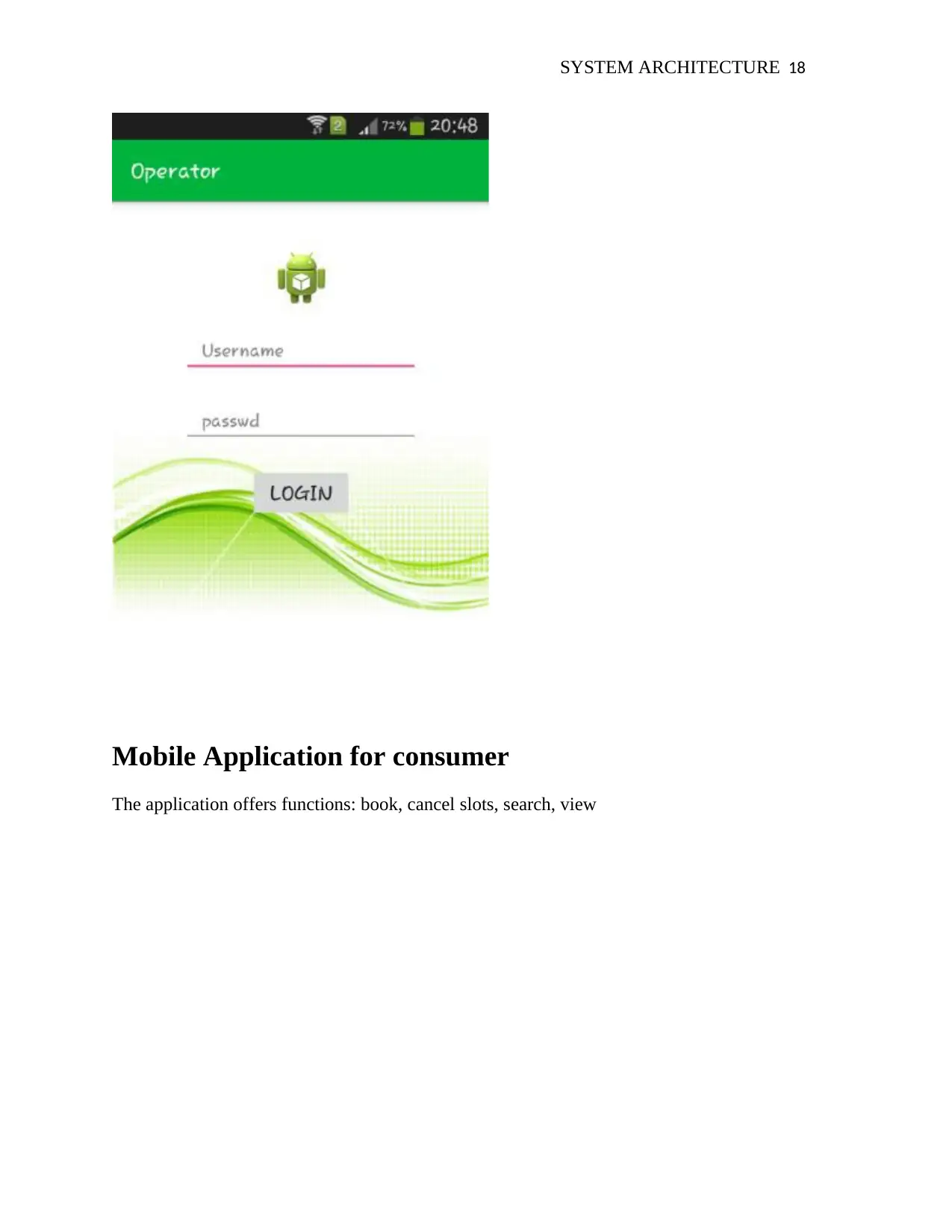
SYSTEM ARCHITECTURE 18
Mobile Application for consumer
The application offers functions: book, cancel slots, search, view
Mobile Application for consumer
The application offers functions: book, cancel slots, search, view
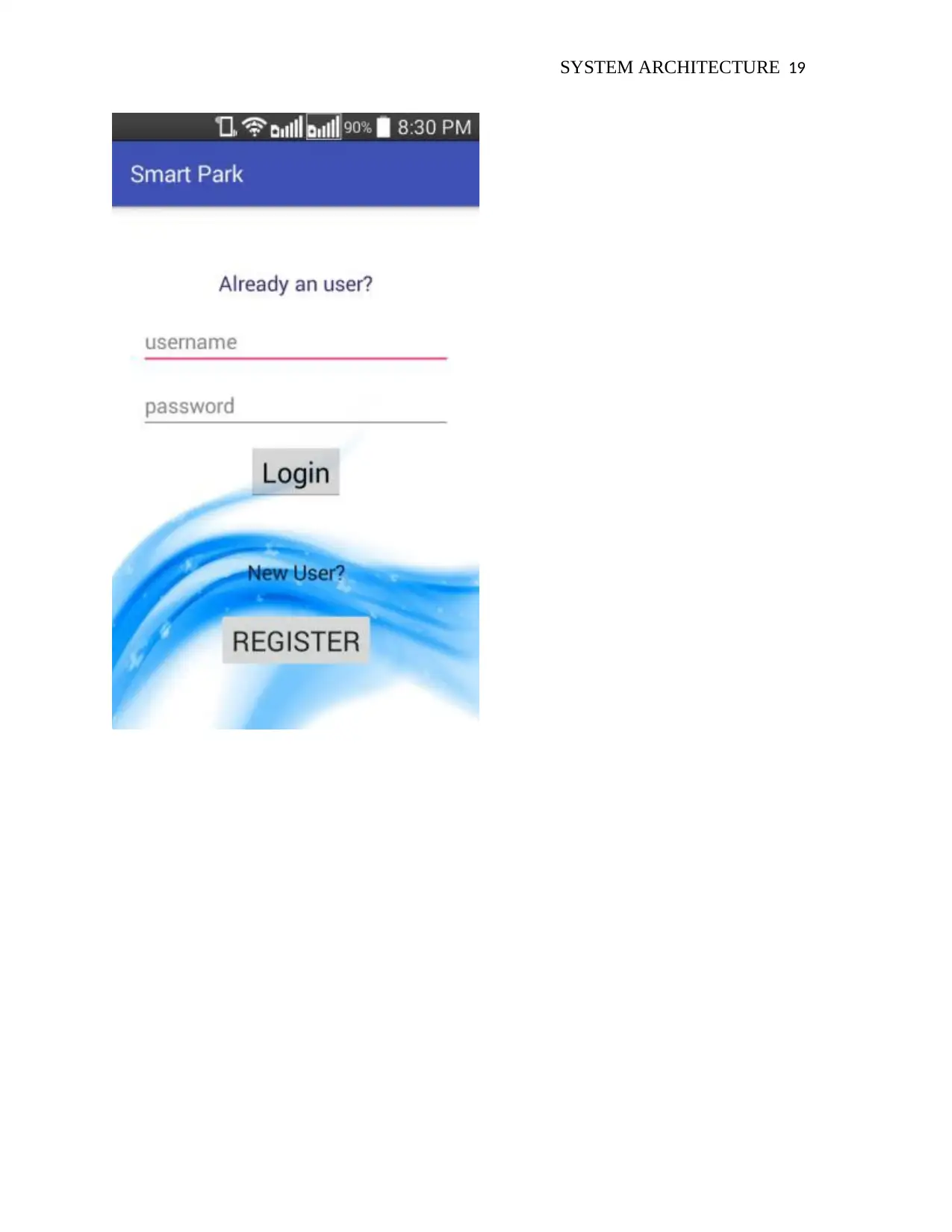
SYSTEM ARCHITECTURE 19
Paraphrase This Document
Need a fresh take? Get an instant paraphrase of this document with our AI Paraphraser
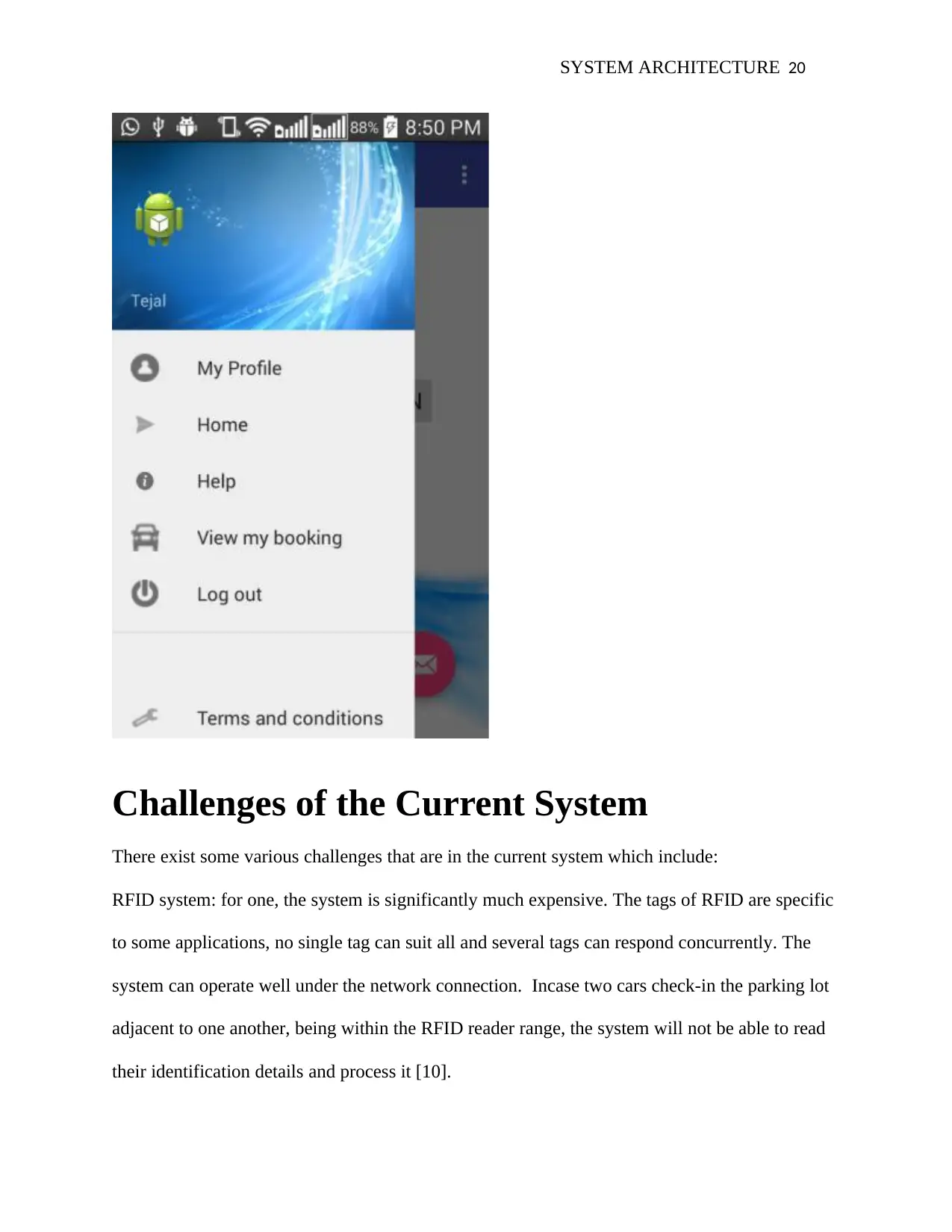
SYSTEM ARCHITECTURE 20
Challenges of the Current System
There exist some various challenges that are in the current system which include:
RFID system: for one, the system is significantly much expensive. The tags of RFID are specific
to some applications, no single tag can suit all and several tags can respond concurrently. The
system can operate well under the network connection. Incase two cars check-in the parking lot
adjacent to one another, being within the RFID reader range, the system will not be able to read
their identification details and process it [10].
Challenges of the Current System
There exist some various challenges that are in the current system which include:
RFID system: for one, the system is significantly much expensive. The tags of RFID are specific
to some applications, no single tag can suit all and several tags can respond concurrently. The
system can operate well under the network connection. Incase two cars check-in the parking lot
adjacent to one another, being within the RFID reader range, the system will not be able to read
their identification details and process it [10].
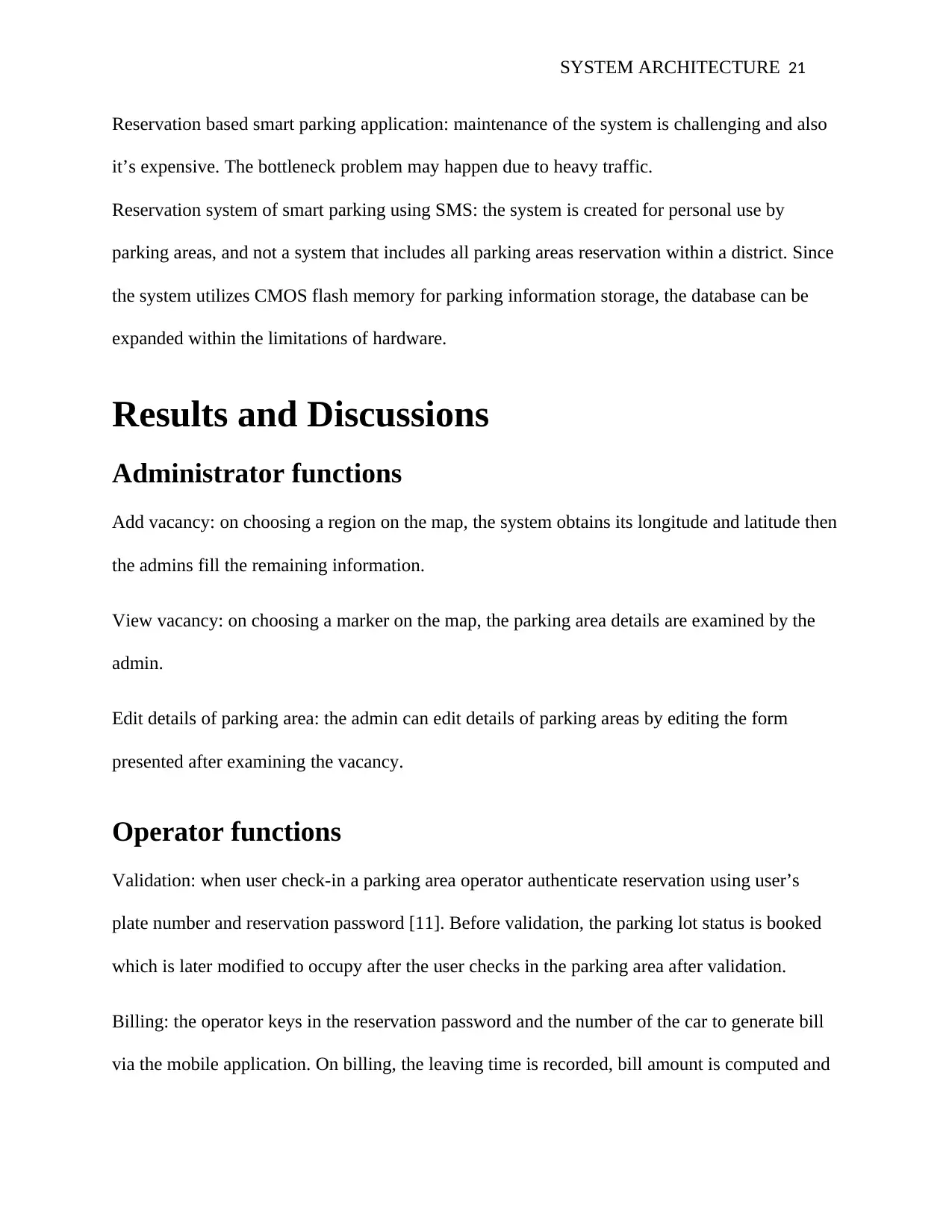
SYSTEM ARCHITECTURE 21
Reservation based smart parking application: maintenance of the system is challenging and also
it’s expensive. The bottleneck problem may happen due to heavy traffic.
Reservation system of smart parking using SMS: the system is created for personal use by
parking areas, and not a system that includes all parking areas reservation within a district. Since
the system utilizes CMOS flash memory for parking information storage, the database can be
expanded within the limitations of hardware.
Results and Discussions
Administrator functions
Add vacancy: on choosing a region on the map, the system obtains its longitude and latitude then
the admins fill the remaining information.
View vacancy: on choosing a marker on the map, the parking area details are examined by the
admin.
Edit details of parking area: the admin can edit details of parking areas by editing the form
presented after examining the vacancy.
Operator functions
Validation: when user check-in a parking area operator authenticate reservation using user’s
plate number and reservation password [11]. Before validation, the parking lot status is booked
which is later modified to occupy after the user checks in the parking area after validation.
Billing: the operator keys in the reservation password and the number of the car to generate bill
via the mobile application. On billing, the leaving time is recorded, bill amount is computed and
Reservation based smart parking application: maintenance of the system is challenging and also
it’s expensive. The bottleneck problem may happen due to heavy traffic.
Reservation system of smart parking using SMS: the system is created for personal use by
parking areas, and not a system that includes all parking areas reservation within a district. Since
the system utilizes CMOS flash memory for parking information storage, the database can be
expanded within the limitations of hardware.
Results and Discussions
Administrator functions
Add vacancy: on choosing a region on the map, the system obtains its longitude and latitude then
the admins fill the remaining information.
View vacancy: on choosing a marker on the map, the parking area details are examined by the
admin.
Edit details of parking area: the admin can edit details of parking areas by editing the form
presented after examining the vacancy.
Operator functions
Validation: when user check-in a parking area operator authenticate reservation using user’s
plate number and reservation password [11]. Before validation, the parking lot status is booked
which is later modified to occupy after the user checks in the parking area after validation.
Billing: the operator keys in the reservation password and the number of the car to generate bill
via the mobile application. On billing, the leaving time is recorded, bill amount is computed and
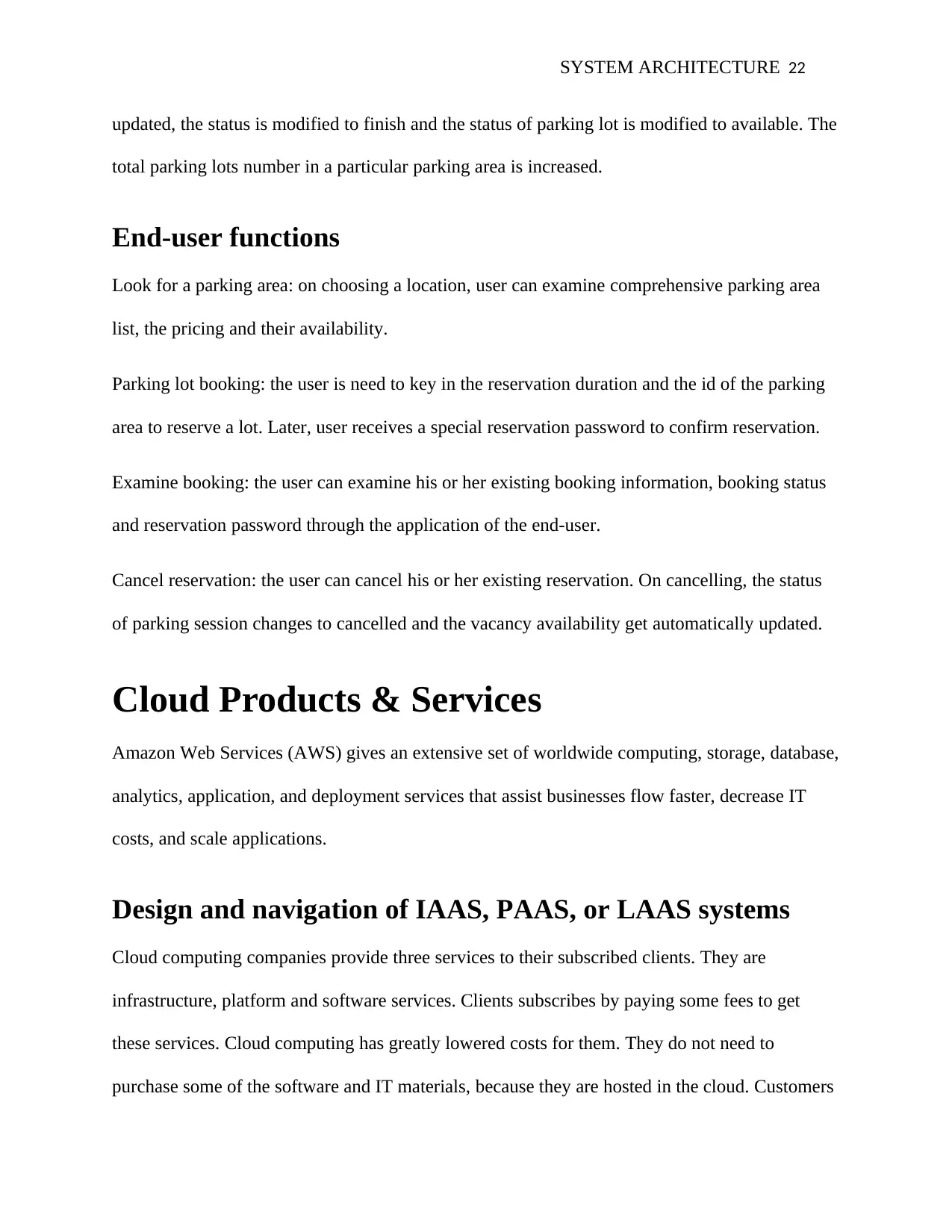
SYSTEM ARCHITECTURE 22
updated, the status is modified to finish and the status of parking lot is modified to available. The
total parking lots number in a particular parking area is increased.
End-user functions
Look for a parking area: on choosing a location, user can examine comprehensive parking area
list, the pricing and their availability.
Parking lot booking: the user is need to key in the reservation duration and the id of the parking
area to reserve a lot. Later, user receives a special reservation password to confirm reservation.
Examine booking: the user can examine his or her existing booking information, booking status
and reservation password through the application of the end-user.
Cancel reservation: the user can cancel his or her existing reservation. On cancelling, the status
of parking session changes to cancelled and the vacancy availability get automatically updated.
Cloud Products & Services
Amazon Web Services (AWS) gives an extensive set of worldwide computing, storage, database,
analytics, application, and deployment services that assist businesses flow faster, decrease IT
costs, and scale applications.
Design and navigation of IAAS, PAAS, or LAAS systems
Cloud computing companies provide three services to their subscribed clients. They are
infrastructure, platform and software services. Clients subscribes by paying some fees to get
these services. Cloud computing has greatly lowered costs for them. They do not need to
purchase some of the software and IT materials, because they are hosted in the cloud. Customers
updated, the status is modified to finish and the status of parking lot is modified to available. The
total parking lots number in a particular parking area is increased.
End-user functions
Look for a parking area: on choosing a location, user can examine comprehensive parking area
list, the pricing and their availability.
Parking lot booking: the user is need to key in the reservation duration and the id of the parking
area to reserve a lot. Later, user receives a special reservation password to confirm reservation.
Examine booking: the user can examine his or her existing booking information, booking status
and reservation password through the application of the end-user.
Cancel reservation: the user can cancel his or her existing reservation. On cancelling, the status
of parking session changes to cancelled and the vacancy availability get automatically updated.
Cloud Products & Services
Amazon Web Services (AWS) gives an extensive set of worldwide computing, storage, database,
analytics, application, and deployment services that assist businesses flow faster, decrease IT
costs, and scale applications.
Design and navigation of IAAS, PAAS, or LAAS systems
Cloud computing companies provide three services to their subscribed clients. They are
infrastructure, platform and software services. Clients subscribes by paying some fees to get
these services. Cloud computing has greatly lowered costs for them. They do not need to
purchase some of the software and IT materials, because they are hosted in the cloud. Customers
Secure Best Marks with AI Grader
Need help grading? Try our AI Grader for instant feedback on your assignments.
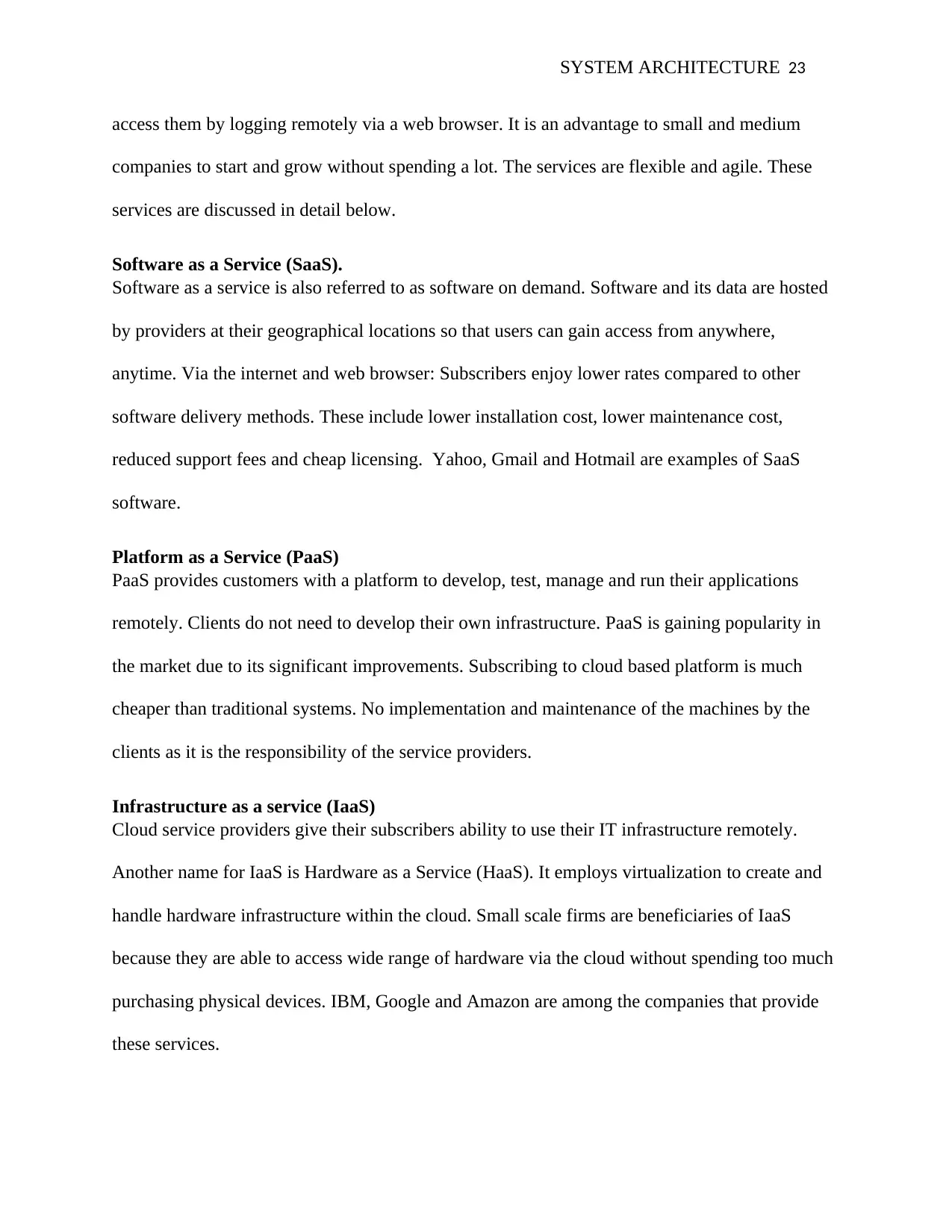
SYSTEM ARCHITECTURE 23
access them by logging remotely via a web browser. It is an advantage to small and medium
companies to start and grow without spending a lot. The services are flexible and agile. These
services are discussed in detail below.
Software as a Service (SaaS).
Software as a service is also referred to as software on demand. Software and its data are hosted
by providers at their geographical locations so that users can gain access from anywhere,
anytime. Via the internet and web browser: Subscribers enjoy lower rates compared to other
software delivery methods. These include lower installation cost, lower maintenance cost,
reduced support fees and cheap licensing. Yahoo, Gmail and Hotmail are examples of SaaS
software.
Platform as a Service (PaaS)
PaaS provides customers with a platform to develop, test, manage and run their applications
remotely. Clients do not need to develop their own infrastructure. PaaS is gaining popularity in
the market due to its significant improvements. Subscribing to cloud based platform is much
cheaper than traditional systems. No implementation and maintenance of the machines by the
clients as it is the responsibility of the service providers.
Infrastructure as a service (IaaS)
Cloud service providers give their subscribers ability to use their IT infrastructure remotely.
Another name for IaaS is Hardware as a Service (HaaS). It employs virtualization to create and
handle hardware infrastructure within the cloud. Small scale firms are beneficiaries of IaaS
because they are able to access wide range of hardware via the cloud without spending too much
purchasing physical devices. IBM, Google and Amazon are among the companies that provide
these services.
access them by logging remotely via a web browser. It is an advantage to small and medium
companies to start and grow without spending a lot. The services are flexible and agile. These
services are discussed in detail below.
Software as a Service (SaaS).
Software as a service is also referred to as software on demand. Software and its data are hosted
by providers at their geographical locations so that users can gain access from anywhere,
anytime. Via the internet and web browser: Subscribers enjoy lower rates compared to other
software delivery methods. These include lower installation cost, lower maintenance cost,
reduced support fees and cheap licensing. Yahoo, Gmail and Hotmail are examples of SaaS
software.
Platform as a Service (PaaS)
PaaS provides customers with a platform to develop, test, manage and run their applications
remotely. Clients do not need to develop their own infrastructure. PaaS is gaining popularity in
the market due to its significant improvements. Subscribing to cloud based platform is much
cheaper than traditional systems. No implementation and maintenance of the machines by the
clients as it is the responsibility of the service providers.
Infrastructure as a service (IaaS)
Cloud service providers give their subscribers ability to use their IT infrastructure remotely.
Another name for IaaS is Hardware as a Service (HaaS). It employs virtualization to create and
handle hardware infrastructure within the cloud. Small scale firms are beneficiaries of IaaS
because they are able to access wide range of hardware via the cloud without spending too much
purchasing physical devices. IBM, Google and Amazon are among the companies that provide
these services.
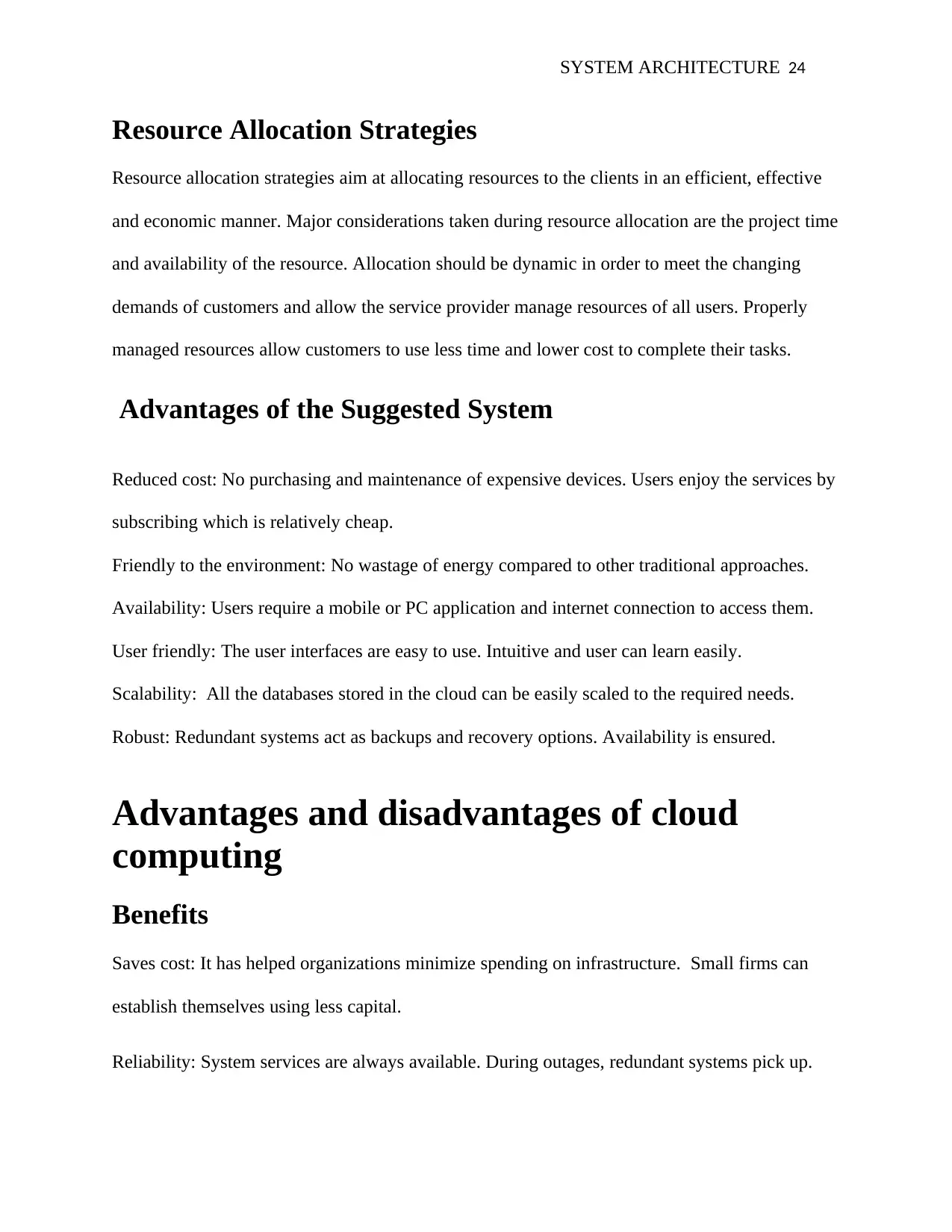
SYSTEM ARCHITECTURE 24
Resource Allocation Strategies
Resource allocation strategies aim at allocating resources to the clients in an efficient, effective
and economic manner. Major considerations taken during resource allocation are the project time
and availability of the resource. Allocation should be dynamic in order to meet the changing
demands of customers and allow the service provider manage resources of all users. Properly
managed resources allow customers to use less time and lower cost to complete their tasks.
Advantages of the Suggested System
Reduced cost: No purchasing and maintenance of expensive devices. Users enjoy the services by
subscribing which is relatively cheap.
Friendly to the environment: No wastage of energy compared to other traditional approaches.
Availability: Users require a mobile or PC application and internet connection to access them.
User friendly: The user interfaces are easy to use. Intuitive and user can learn easily.
Scalability: All the databases stored in the cloud can be easily scaled to the required needs.
Robust: Redundant systems act as backups and recovery options. Availability is ensured.
Advantages and disadvantages of cloud
computing
Benefits
Saves cost: It has helped organizations minimize spending on infrastructure. Small firms can
establish themselves using less capital.
Reliability: System services are always available. During outages, redundant systems pick up.
Resource Allocation Strategies
Resource allocation strategies aim at allocating resources to the clients in an efficient, effective
and economic manner. Major considerations taken during resource allocation are the project time
and availability of the resource. Allocation should be dynamic in order to meet the changing
demands of customers and allow the service provider manage resources of all users. Properly
managed resources allow customers to use less time and lower cost to complete their tasks.
Advantages of the Suggested System
Reduced cost: No purchasing and maintenance of expensive devices. Users enjoy the services by
subscribing which is relatively cheap.
Friendly to the environment: No wastage of energy compared to other traditional approaches.
Availability: Users require a mobile or PC application and internet connection to access them.
User friendly: The user interfaces are easy to use. Intuitive and user can learn easily.
Scalability: All the databases stored in the cloud can be easily scaled to the required needs.
Robust: Redundant systems act as backups and recovery options. Availability is ensured.
Advantages and disadvantages of cloud
computing
Benefits
Saves cost: It has helped organizations minimize spending on infrastructure. Small firms can
establish themselves using less capital.
Reliability: System services are always available. During outages, redundant systems pick up.
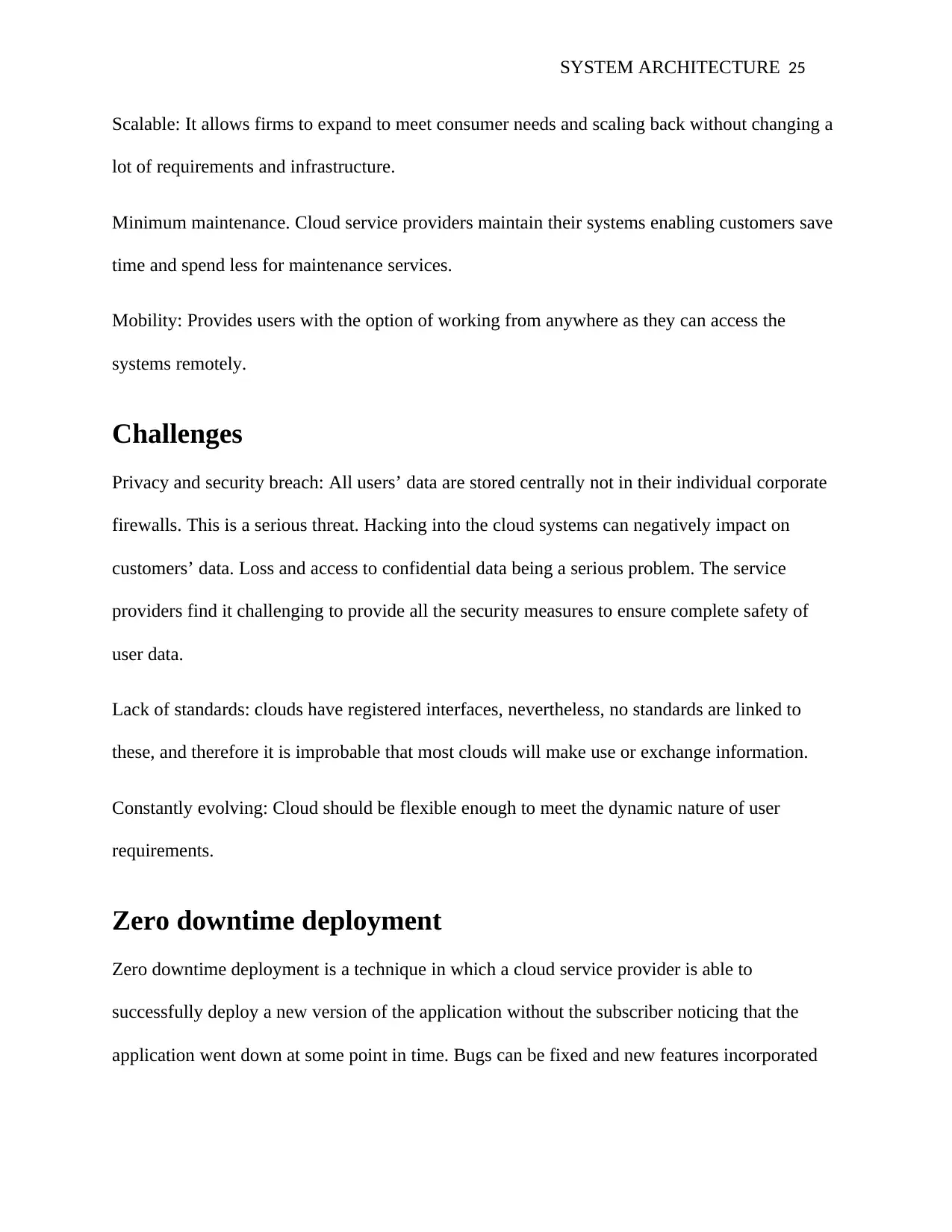
SYSTEM ARCHITECTURE 25
Scalable: It allows firms to expand to meet consumer needs and scaling back without changing a
lot of requirements and infrastructure.
Minimum maintenance. Cloud service providers maintain their systems enabling customers save
time and spend less for maintenance services.
Mobility: Provides users with the option of working from anywhere as they can access the
systems remotely.
Challenges
Privacy and security breach: All users’ data are stored centrally not in their individual corporate
firewalls. This is a serious threat. Hacking into the cloud systems can negatively impact on
customers’ data. Loss and access to confidential data being a serious problem. The service
providers find it challenging to provide all the security measures to ensure complete safety of
user data.
Lack of standards: clouds have registered interfaces, nevertheless, no standards are linked to
these, and therefore it is improbable that most clouds will make use or exchange information.
Constantly evolving: Cloud should be flexible enough to meet the dynamic nature of user
requirements.
Zero downtime deployment
Zero downtime deployment is a technique in which a cloud service provider is able to
successfully deploy a new version of the application without the subscriber noticing that the
application went down at some point in time. Bugs can be fixed and new features incorporated
Scalable: It allows firms to expand to meet consumer needs and scaling back without changing a
lot of requirements and infrastructure.
Minimum maintenance. Cloud service providers maintain their systems enabling customers save
time and spend less for maintenance services.
Mobility: Provides users with the option of working from anywhere as they can access the
systems remotely.
Challenges
Privacy and security breach: All users’ data are stored centrally not in their individual corporate
firewalls. This is a serious threat. Hacking into the cloud systems can negatively impact on
customers’ data. Loss and access to confidential data being a serious problem. The service
providers find it challenging to provide all the security measures to ensure complete safety of
user data.
Lack of standards: clouds have registered interfaces, nevertheless, no standards are linked to
these, and therefore it is improbable that most clouds will make use or exchange information.
Constantly evolving: Cloud should be flexible enough to meet the dynamic nature of user
requirements.
Zero downtime deployment
Zero downtime deployment is a technique in which a cloud service provider is able to
successfully deploy a new version of the application without the subscriber noticing that the
application went down at some point in time. Bugs can be fixed and new features incorporated
Paraphrase This Document
Need a fresh take? Get an instant paraphrase of this document with our AI Paraphraser
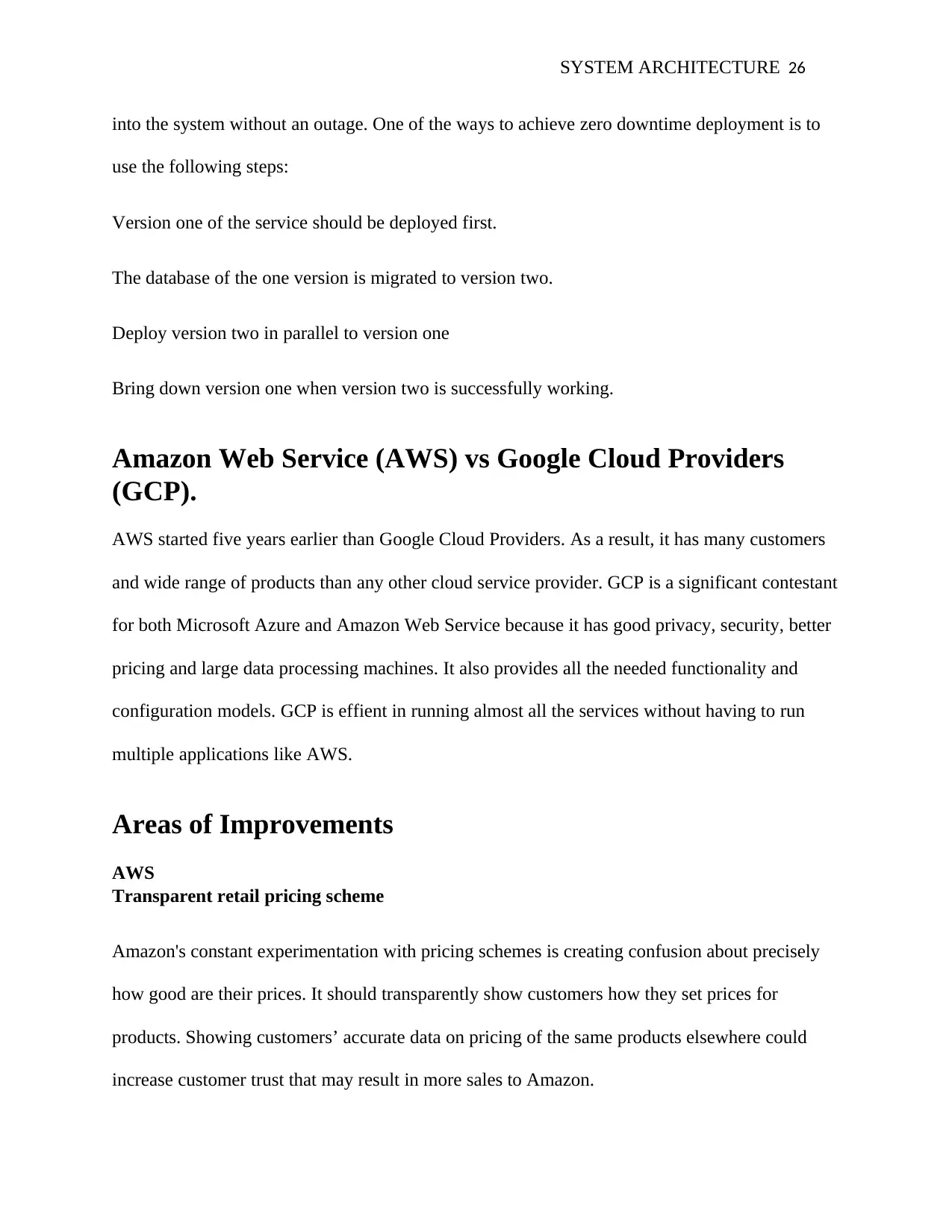
SYSTEM ARCHITECTURE 26
into the system without an outage. One of the ways to achieve zero downtime deployment is to
use the following steps:
Version one of the service should be deployed first.
The database of the one version is migrated to version two.
Deploy version two in parallel to version one
Bring down version one when version two is successfully working.
Amazon Web Service (AWS) vs Google Cloud Providers
(GCP).
AWS started five years earlier than Google Cloud Providers. As a result, it has many customers
and wide range of products than any other cloud service provider. GCP is a significant contestant
for both Microsoft Azure and Amazon Web Service because it has good privacy, security, better
pricing and large data processing machines. It also provides all the needed functionality and
configuration models. GCP is effient in running almost all the services without having to run
multiple applications like AWS.
Areas of Improvements
AWS
Transparent retail pricing scheme
Amazon's constant experimentation with pricing schemes is creating confusion about precisely
how good are their prices. It should transparently show customers how they set prices for
products. Showing customers’ accurate data on pricing of the same products elsewhere could
increase customer trust that may result in more sales to Amazon.
into the system without an outage. One of the ways to achieve zero downtime deployment is to
use the following steps:
Version one of the service should be deployed first.
The database of the one version is migrated to version two.
Deploy version two in parallel to version one
Bring down version one when version two is successfully working.
Amazon Web Service (AWS) vs Google Cloud Providers
(GCP).
AWS started five years earlier than Google Cloud Providers. As a result, it has many customers
and wide range of products than any other cloud service provider. GCP is a significant contestant
for both Microsoft Azure and Amazon Web Service because it has good privacy, security, better
pricing and large data processing machines. It also provides all the needed functionality and
configuration models. GCP is effient in running almost all the services without having to run
multiple applications like AWS.
Areas of Improvements
AWS
Transparent retail pricing scheme
Amazon's constant experimentation with pricing schemes is creating confusion about precisely
how good are their prices. It should transparently show customers how they set prices for
products. Showing customers’ accurate data on pricing of the same products elsewhere could
increase customer trust that may result in more sales to Amazon.
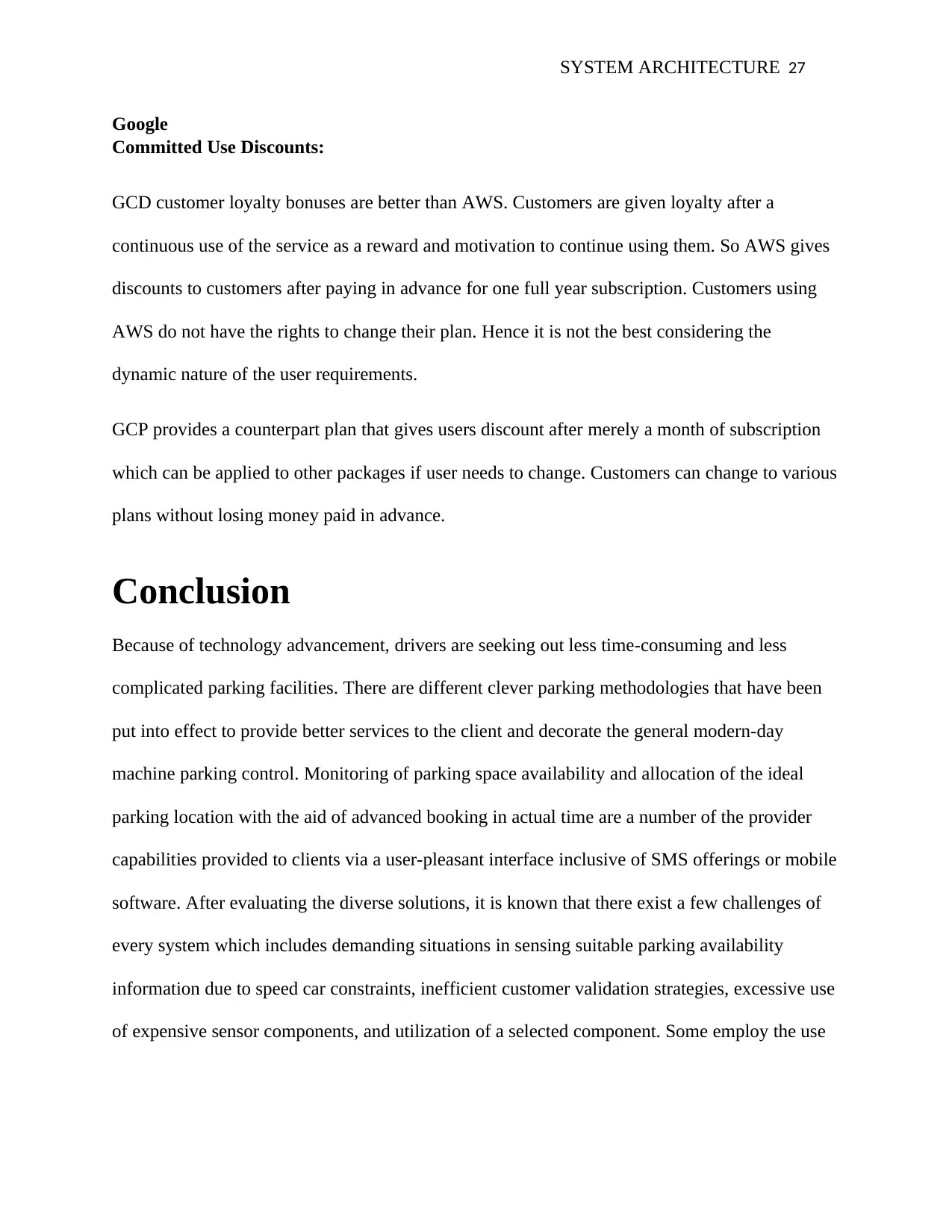
SYSTEM ARCHITECTURE 27
Google
Committed Use Discounts:
GCD customer loyalty bonuses are better than AWS. Customers are given loyalty after a
continuous use of the service as a reward and motivation to continue using them. So AWS gives
discounts to customers after paying in advance for one full year subscription. Customers using
AWS do not have the rights to change their plan. Hence it is not the best considering the
dynamic nature of the user requirements.
GCP provides a counterpart plan that gives users discount after merely a month of subscription
which can be applied to other packages if user needs to change. Customers can change to various
plans without losing money paid in advance.
Conclusion
Because of technology advancement, drivers are seeking out less time-consuming and less
complicated parking facilities. There are different clever parking methodologies that have been
put into effect to provide better services to the client and decorate the general modern-day
machine parking control. Monitoring of parking space availability and allocation of the ideal
parking location with the aid of advanced booking in actual time are a number of the provider
capabilities provided to clients via a user-pleasant interface inclusive of SMS offerings or mobile
software. After evaluating the diverse solutions, it is known that there exist a few challenges of
every system which includes demanding situations in sensing suitable parking availability
information due to speed car constraints, inefficient customer validation strategies, excessive use
of expensive sensor components, and utilization of a selected component. Some employ the use
Committed Use Discounts:
GCD customer loyalty bonuses are better than AWS. Customers are given loyalty after a
continuous use of the service as a reward and motivation to continue using them. So AWS gives
discounts to customers after paying in advance for one full year subscription. Customers using
AWS do not have the rights to change their plan. Hence it is not the best considering the
dynamic nature of the user requirements.
GCP provides a counterpart plan that gives users discount after merely a month of subscription
which can be applied to other packages if user needs to change. Customers can change to various
plans without losing money paid in advance.
Conclusion
Because of technology advancement, drivers are seeking out less time-consuming and less
complicated parking facilities. There are different clever parking methodologies that have been
put into effect to provide better services to the client and decorate the general modern-day
machine parking control. Monitoring of parking space availability and allocation of the ideal
parking location with the aid of advanced booking in actual time are a number of the provider
capabilities provided to clients via a user-pleasant interface inclusive of SMS offerings or mobile
software. After evaluating the diverse solutions, it is known that there exist a few challenges of
every system which includes demanding situations in sensing suitable parking availability
information due to speed car constraints, inefficient customer validation strategies, excessive use
of expensive sensor components, and utilization of a selected component. Some employ the use
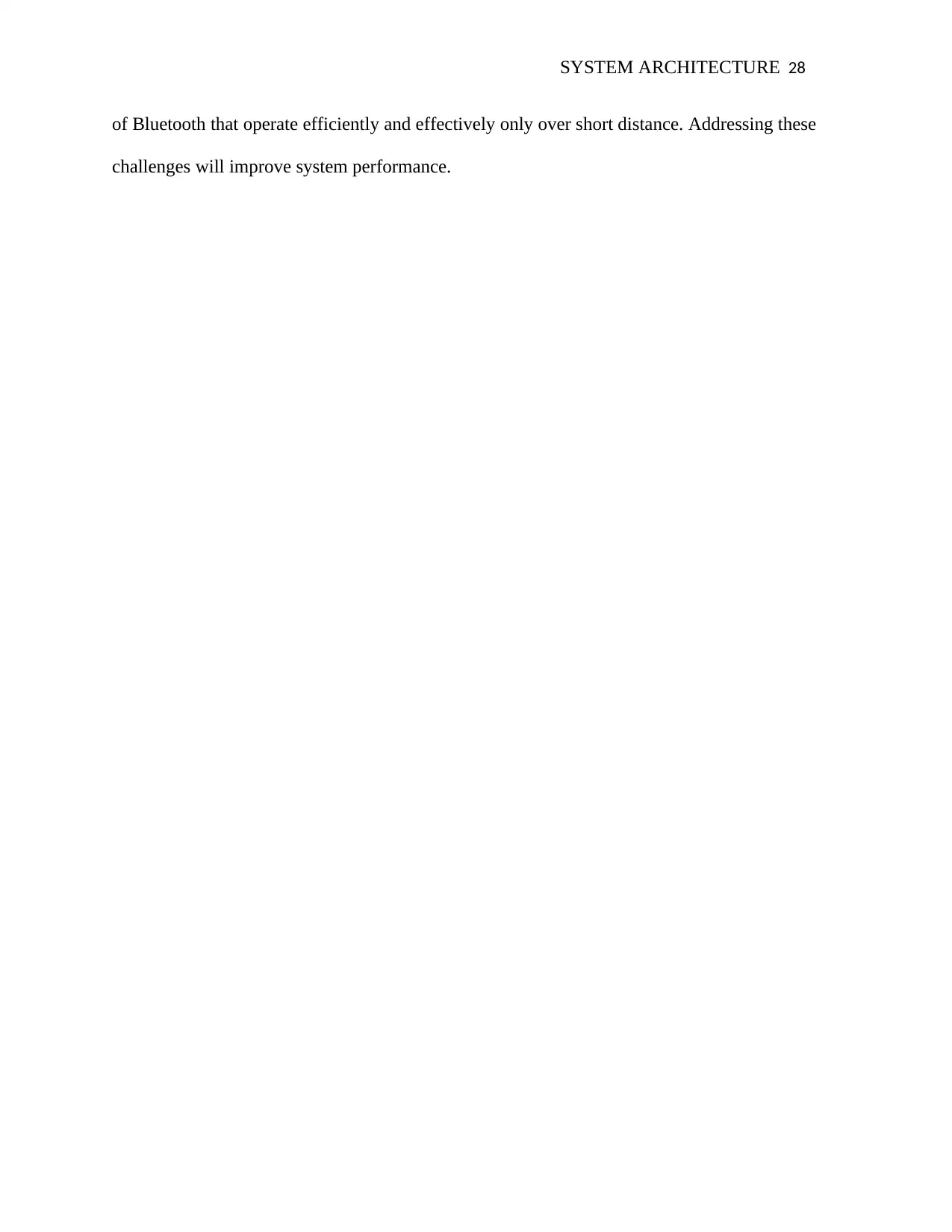
SYSTEM ARCHITECTURE 28
of Bluetooth that operate efficiently and effectively only over short distance. Addressing these
challenges will improve system performance.
of Bluetooth that operate efficiently and effectively only over short distance. Addressing these
challenges will improve system performance.
Secure Best Marks with AI Grader
Need help grading? Try our AI Grader for instant feedback on your assignments.
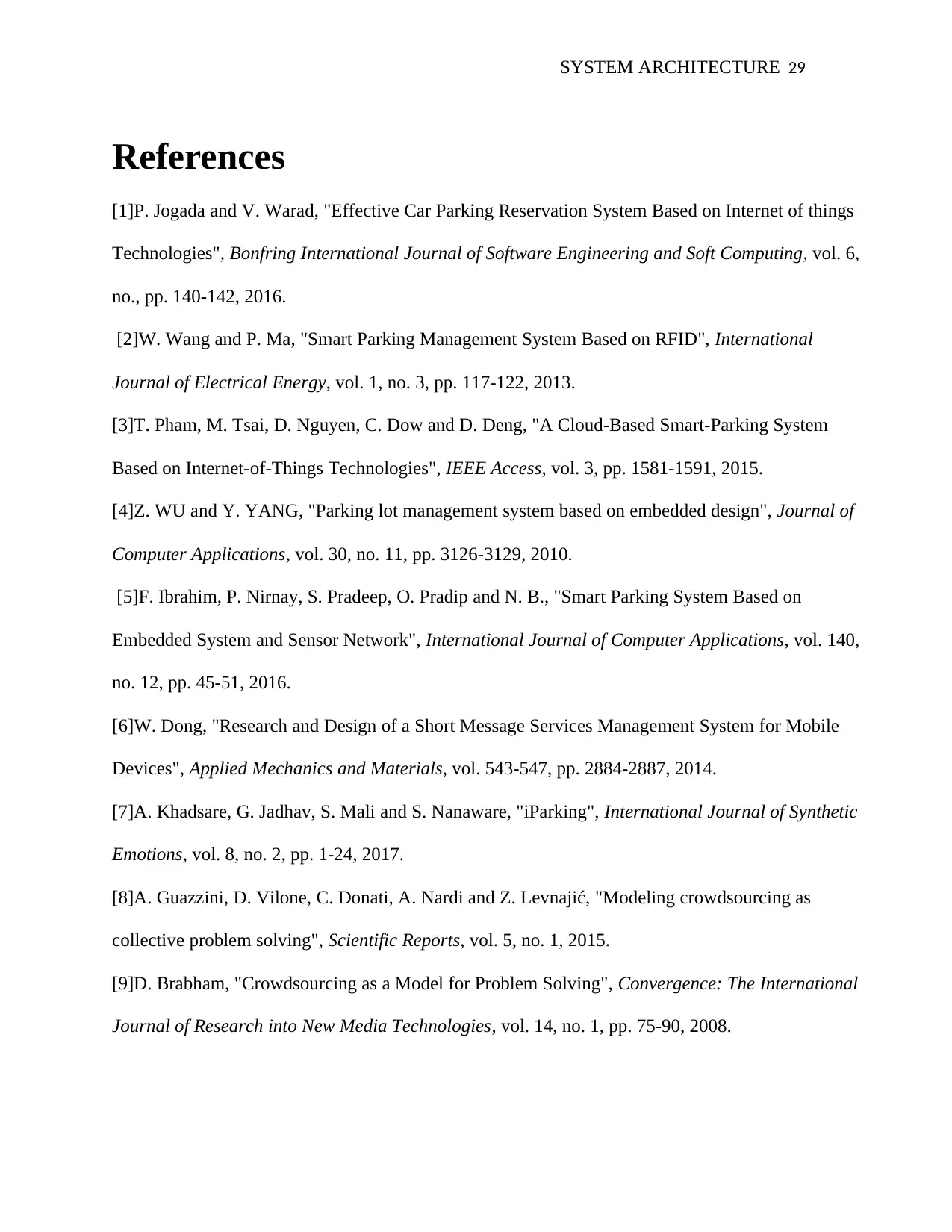
SYSTEM ARCHITECTURE 29
References
[1]P. Jogada and V. Warad, "Effective Car Parking Reservation System Based on Internet of things
Technologies", Bonfring International Journal of Software Engineering and Soft Computing, vol. 6,
no., pp. 140-142, 2016.
[2]W. Wang and P. Ma, "Smart Parking Management System Based on RFID", International
Journal of Electrical Energy, vol. 1, no. 3, pp. 117-122, 2013.
[3]T. Pham, M. Tsai, D. Nguyen, C. Dow and D. Deng, "A Cloud-Based Smart-Parking System
Based on Internet-of-Things Technologies", IEEE Access, vol. 3, pp. 1581-1591, 2015.
[4]Z. WU and Y. YANG, "Parking lot management system based on embedded design", Journal of
Computer Applications, vol. 30, no. 11, pp. 3126-3129, 2010.
[5]F. Ibrahim, P. Nirnay, S. Pradeep, O. Pradip and N. B., "Smart Parking System Based on
Embedded System and Sensor Network", International Journal of Computer Applications, vol. 140,
no. 12, pp. 45-51, 2016.
[6]W. Dong, "Research and Design of a Short Message Services Management System for Mobile
Devices", Applied Mechanics and Materials, vol. 543-547, pp. 2884-2887, 2014.
[7]A. Khadsare, G. Jadhav, S. Mali and S. Nanaware, "iParking", International Journal of Synthetic
Emotions, vol. 8, no. 2, pp. 1-24, 2017.
[8]A. Guazzini, D. Vilone, C. Donati, A. Nardi and Z. Levnajić, "Modeling crowdsourcing as
collective problem solving", Scientific Reports, vol. 5, no. 1, 2015.
[9]D. Brabham, "Crowdsourcing as a Model for Problem Solving", Convergence: The International
Journal of Research into New Media Technologies, vol. 14, no. 1, pp. 75-90, 2008.
References
[1]P. Jogada and V. Warad, "Effective Car Parking Reservation System Based on Internet of things
Technologies", Bonfring International Journal of Software Engineering and Soft Computing, vol. 6,
no., pp. 140-142, 2016.
[2]W. Wang and P. Ma, "Smart Parking Management System Based on RFID", International
Journal of Electrical Energy, vol. 1, no. 3, pp. 117-122, 2013.
[3]T. Pham, M. Tsai, D. Nguyen, C. Dow and D. Deng, "A Cloud-Based Smart-Parking System
Based on Internet-of-Things Technologies", IEEE Access, vol. 3, pp. 1581-1591, 2015.
[4]Z. WU and Y. YANG, "Parking lot management system based on embedded design", Journal of
Computer Applications, vol. 30, no. 11, pp. 3126-3129, 2010.
[5]F. Ibrahim, P. Nirnay, S. Pradeep, O. Pradip and N. B., "Smart Parking System Based on
Embedded System and Sensor Network", International Journal of Computer Applications, vol. 140,
no. 12, pp. 45-51, 2016.
[6]W. Dong, "Research and Design of a Short Message Services Management System for Mobile
Devices", Applied Mechanics and Materials, vol. 543-547, pp. 2884-2887, 2014.
[7]A. Khadsare, G. Jadhav, S. Mali and S. Nanaware, "iParking", International Journal of Synthetic
Emotions, vol. 8, no. 2, pp. 1-24, 2017.
[8]A. Guazzini, D. Vilone, C. Donati, A. Nardi and Z. Levnajić, "Modeling crowdsourcing as
collective problem solving", Scientific Reports, vol. 5, no. 1, 2015.
[9]D. Brabham, "Crowdsourcing as a Model for Problem Solving", Convergence: The International
Journal of Research into New Media Technologies, vol. 14, no. 1, pp. 75-90, 2008.
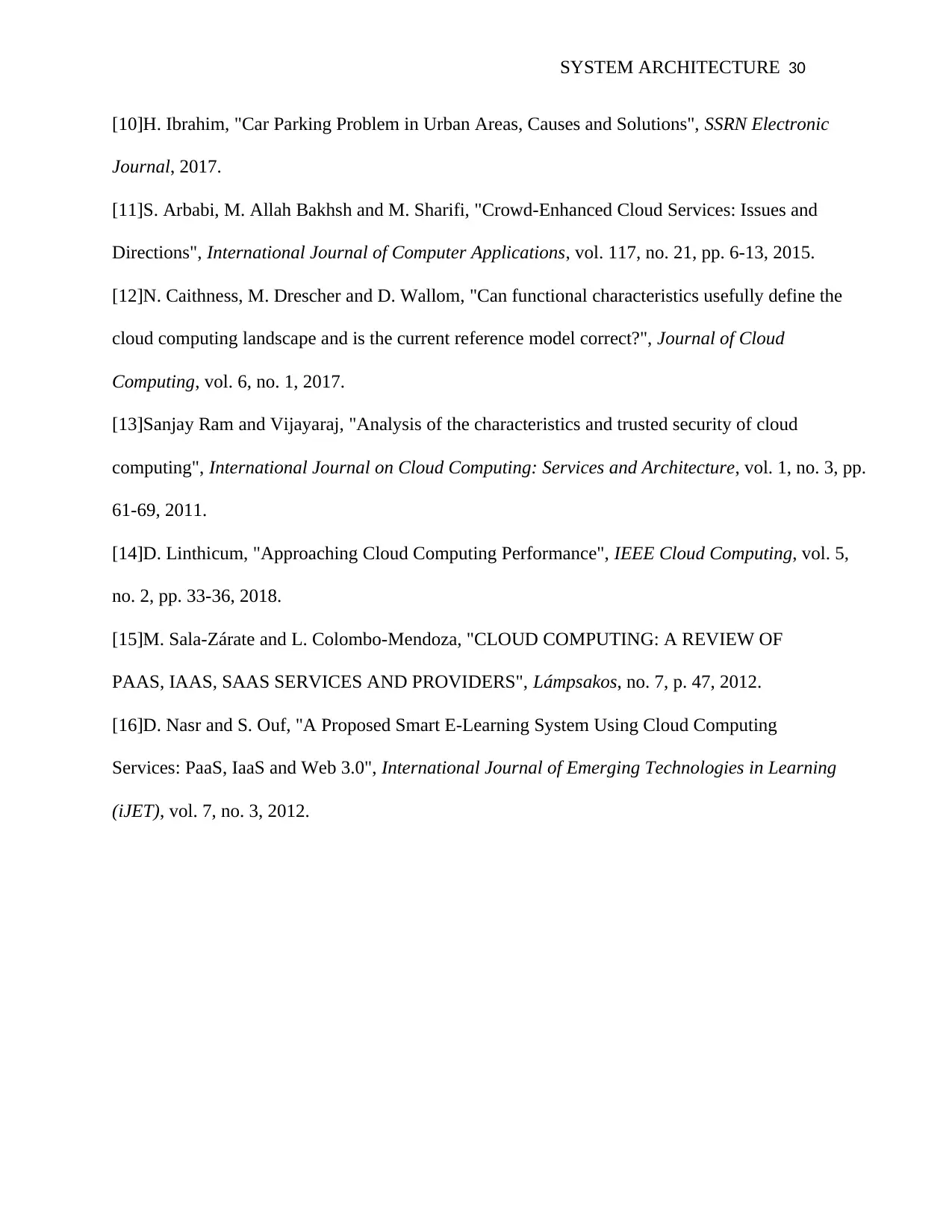
SYSTEM ARCHITECTURE 30
[10]H. Ibrahim, "Car Parking Problem in Urban Areas, Causes and Solutions", SSRN Electronic
Journal, 2017.
[11]S. Arbabi, M. Allah Bakhsh and M. Sharifi, "Crowd-Enhanced Cloud Services: Issues and
Directions", International Journal of Computer Applications, vol. 117, no. 21, pp. 6-13, 2015.
[12]N. Caithness, M. Drescher and D. Wallom, "Can functional characteristics usefully define the
cloud computing landscape and is the current reference model correct?", Journal of Cloud
Computing, vol. 6, no. 1, 2017.
[13]Sanjay Ram and Vijayaraj, "Analysis of the characteristics and trusted security of cloud
computing", International Journal on Cloud Computing: Services and Architecture, vol. 1, no. 3, pp.
61-69, 2011.
[14]D. Linthicum, "Approaching Cloud Computing Performance", IEEE Cloud Computing, vol. 5,
no. 2, pp. 33-36, 2018.
[15]M. Sala-Zárate and L. Colombo-Mendoza, "CLOUD COMPUTING: A REVIEW OF
PAAS, IAAS, SAAS SERVICES AND PROVIDERS", Lámpsakos, no. 7, p. 47, 2012.
[16]D. Nasr and S. Ouf, "A Proposed Smart E-Learning System Using Cloud Computing
Services: PaaS, IaaS and Web 3.0", International Journal of Emerging Technologies in Learning
(iJET), vol. 7, no. 3, 2012.
[10]H. Ibrahim, "Car Parking Problem in Urban Areas, Causes and Solutions", SSRN Electronic
Journal, 2017.
[11]S. Arbabi, M. Allah Bakhsh and M. Sharifi, "Crowd-Enhanced Cloud Services: Issues and
Directions", International Journal of Computer Applications, vol. 117, no. 21, pp. 6-13, 2015.
[12]N. Caithness, M. Drescher and D. Wallom, "Can functional characteristics usefully define the
cloud computing landscape and is the current reference model correct?", Journal of Cloud
Computing, vol. 6, no. 1, 2017.
[13]Sanjay Ram and Vijayaraj, "Analysis of the characteristics and trusted security of cloud
computing", International Journal on Cloud Computing: Services and Architecture, vol. 1, no. 3, pp.
61-69, 2011.
[14]D. Linthicum, "Approaching Cloud Computing Performance", IEEE Cloud Computing, vol. 5,
no. 2, pp. 33-36, 2018.
[15]M. Sala-Zárate and L. Colombo-Mendoza, "CLOUD COMPUTING: A REVIEW OF
PAAS, IAAS, SAAS SERVICES AND PROVIDERS", Lámpsakos, no. 7, p. 47, 2012.
[16]D. Nasr and S. Ouf, "A Proposed Smart E-Learning System Using Cloud Computing
Services: PaaS, IaaS and Web 3.0", International Journal of Emerging Technologies in Learning
(iJET), vol. 7, no. 3, 2012.
1 out of 30
Related Documents
Your All-in-One AI-Powered Toolkit for Academic Success.
+13062052269
info@desklib.com
Available 24*7 on WhatsApp / Email
![[object Object]](/_next/static/media/star-bottom.7253800d.svg)
Unlock your academic potential
© 2024 | Zucol Services PVT LTD | All rights reserved.




